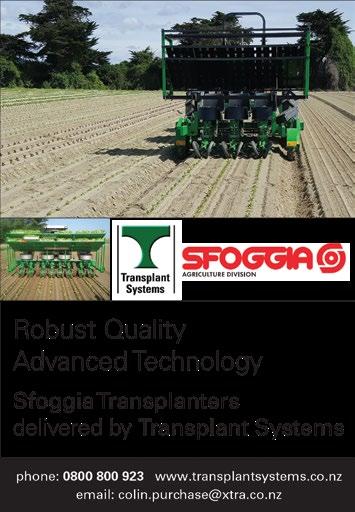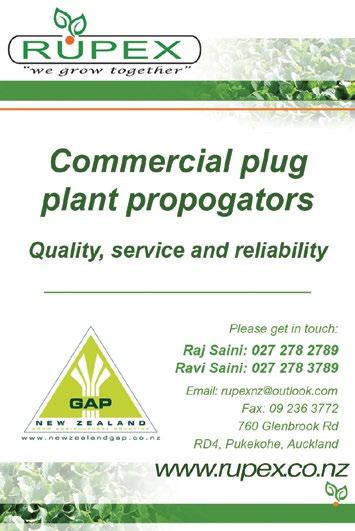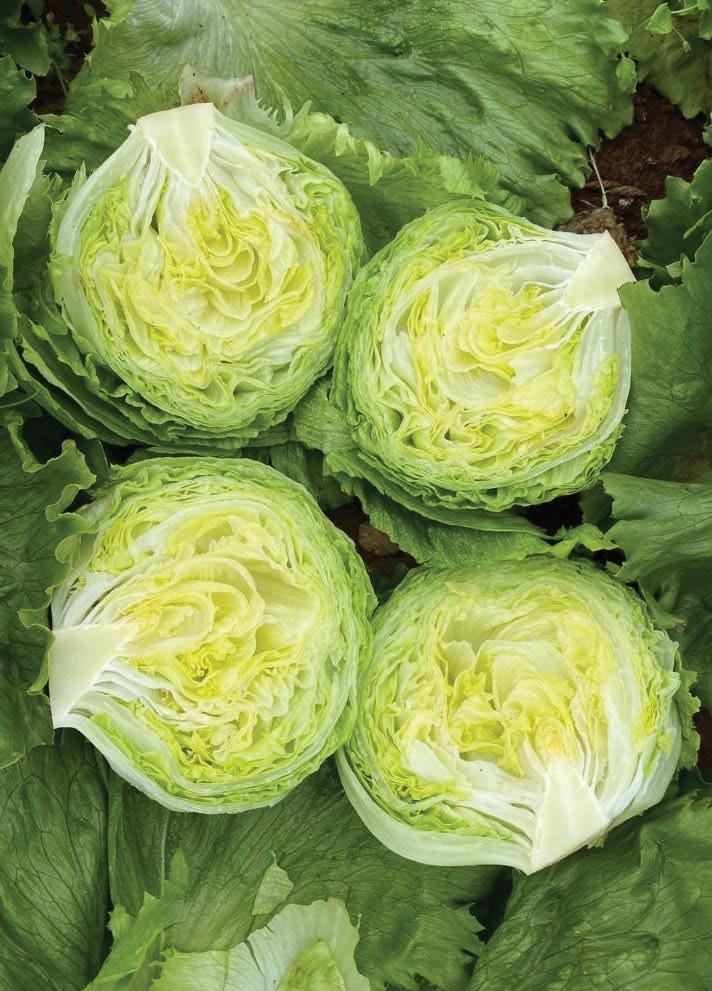CONNECTING EVERY GROWER



it comes to harvesting, ASA-LIFT brings you innovative, specialised crop solutions to drive production further.

Since 1936 ASA-LIFT has built a solid reputation for quality, innovation and constant evolution to meet market demands. Maximise your harvest with an ASA-LIFT mounted, trailed or self propelled vegetable harvester - now proudly available from LANDPOWER Vegetable Centre.
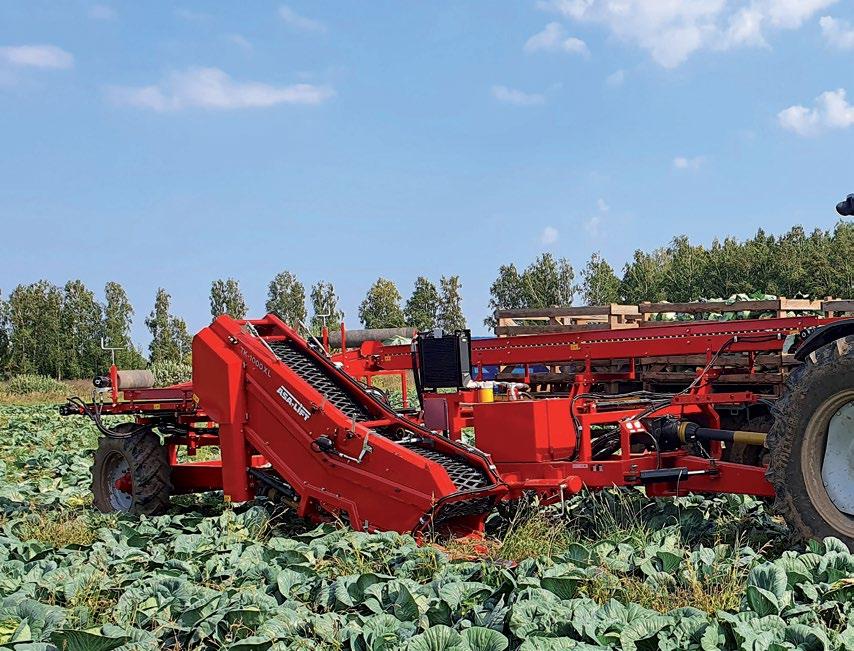


2 President’s Word: What a great combined conference we just had!
4 The Chief Executive: GST is not the issue keeping fruit and vegetable growers awake at night
7 Inaugural Horticulture Conference Week hailed a success
8 Horticulture awards
12 HortNZ Life membership awards
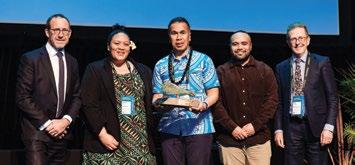
14 Horticulture the future for sustainable food
18 Mind the cultural gap to reduce injuries
22 Importance of fruit and vegetables recognised after years of advocacy work
29 New voice for smaller growers
34 Have your say on the NZGAP review
38 Rural Support Trust reaching out across the rohe
43 Applications of continuous soil moisture monitoring technology for industry best practice nutrient management
48 An extreme year for many regions
PRODUCT GROUPS
51 Vegetables Sessions at the Horticulture Conference Week
Vegetables.co.nz
55 Promoting New Zealand grown vegetables – to everyone
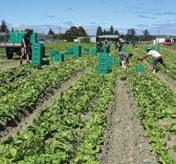
TomatoesNZ Inc.
56 More support needed for growers to decarbonise the industry
58 Greenhouse diseases: Prevention is better than eradication
Potatoes NZ Inc.
60 Reflecting on an exceptional Potatoes NZ Conference experience
Vegetables NZ Inc.
62 Geo-heat in horticulture: An opportunity for unlimited, cheap energy
64 Grow your IPM expertise through in-field workshops
Onions NZ Inc.
66 Using smart Kiwi tech to reduce fungicide use
58
TomatoesNZ’s newest board member, Jungeun (Jiny) Kim, in Waiuku, see page 29. Photo by Helena O’Neill.
A regular advertorial section of new products and services. This publication does not endorse the products or services featured here.
69 Adama – New Nimitz® nematode control equals OPs without the risks
70 NZ Foam – Innovating Crop Storage: Agrarian Advancements with Spray Foam Insulation

71 Arysta – Decreasing the water tension
FINAL PICK
72 Have you started your Freshwater Farm Plan?

Nearly 1000 of us had the opportunity to attend the Horticulture, Recognised Seasonal Employer (RSE), New Zealand Apples and Pears, and the Vegetable groups conferences in Te Pae, Christchurch recently – combined for the first time in the Horticulture Conference Week. What an awesome event – from the really amazing venue, the programme and speakers, to the fantastic networking, right down to the food.
A special thanks to chief executive Nadine Tunley and the HortNZ team for the huge amount of excellent organisation in bringing the week of events together, no doubt herding a few cats along the way, but in delivering what to me was the best conference we have put together. And while it’s been an awful year for horticulture, it’s also nice to be able to come together and to celebrate some of the great leaders in our sector who have done some really amazing work over their careers. Our gala dinner was the largest ever, with nearly 700 people attending; including Ministers Andrew Little and Damien O’Connor who were present to witness how the industry values and respects our RSE scheme families from the Pacific. What an amazing evening of celebration.
And congratulations to all the award winners recognised at the gala dinner and Annual General Meetings, especially to Max Lilley who received the Bledisloe Cup, and Colin Jenkins the President’s award. All were very worthy recipients, and it was fantastic to hear their experiences and reflections on receiving the awards.
We also had our AGM at the conference, as did a number of product groups, and I would like to thank all our members for the ongoing support, including feedback on how we can do even better. AGMs are funny old things – by law we have to progress through a number of resolutions that might be seen as boring or going through the motions, but in reality this is an important part of an organisation’s accountability and transparency to its members. It also gives members the opportunity to raise issues for clarification or improvement.
The conference to me was also better because of one thing, and that one thing was that we were together as a combined horticulture whānau. It was the inaugural conference in bringing together a horticulture collective.
It was much better for being a combined conference without doubt, and I hope that the experience we all had will result in even bigger collectives combining for years to come.
We had great support from sponsors and exhibitors, who are critical to make an event like this happen. A big thanks also to all the speakers who spent time putting presentations together. Good conferences don’t happen without really good MCs and we were blessed also with the wonderful Caren Rangi, and Alaisdair colourful shoes MacLeod; well done both, amazing efforts and much appreciated.
Many of the presenters during the week emphasised the same thing –that working together we benefit from the collaboration and the strength of voice that happens when we are one. I raised at our AGM the encouraging efforts that I am seeing across horticulture where we are looking at how we can better collaborate. Collaboration ensures we are delivering greater value to our levy payers, avoiding duplication, and achieving stronger advocacy to government.
We need to commit to landing this, and not fall into the trap of just talking for the next 12 months about what this could be.
A number of the product groups including HortNZ are about to enter into consultation and then early next year will vote to determine whether growers and our members agree to another six years of commodity levies, which form the basis of our advocacy work for growers.

I encourage growers to engage in this process to ensure we understand what we need to do more of and better, and also what we need to do less of or differently. In today’s very complex operating environment, it is impossible for every group to do everything, and in my opinion one of the problems we absolutely have to stop is everyone is trying to do everything. Instead we should be collaborating and in the process being very clear about who is going to be doing what.
During the AGM we said goodbye to Tony Howey, a long-standing board member of HortNZ and Chair of the NZGAP (Good Agriculture Practice) committee. In his last email to the board Tony as gracious as always, said “I’ve been very fortunate in my governance roles where directors and management have put the interests of the organisation above their personal ambitions and maintained this unity of purpose – something that has been very evident in the HortNZ boardroom. So much more can be achieved when unity and respect for others with different points of view are part of the modus operandi.”
Thank you Tony and I very much share your sentiment, and we wish you all the very best for your business and governance roles into the future. Finally, one of the most powerful speakers at the conference to me was Matt Chisholm, who gave a humorous but very honest account of his struggle with his demons during his earlier career. It was an inspirational presentation, from the heart and with a strong message to us all about the need to look after ourselves and each other, and to get help when we need it, rather than continuing to battle something that we are unlikely to cure on our own.
It’s still tough at the moment in horticulture, so look after yourself and each other. And if you can, try to get to the conference next year. For me it was a very uplifting event.
Kia kahaNEARLY 1000 OF US HAD THE OPPORTUNITY TO ATTEND THE HORTICULTURE, RECOGNISED SEASONAL EMPLOYER (RSE), NEW ZEALAND APPLES AND PEARS, AND THE VEGETABLE GROUPS CONFERENCES
Editor:
Andrew Bristol
Ph: 021 021 62 021
Email: andrew.bristol@hortnz.co.nz
Advertising Manager:
Debbie Pascoe
Ph: 027 485 8562
Email: debbie.pascoe@hortnz.co.nz
Design: Scenario Communications
Ph: 04 385 9766
Email: joy@scenario.co.nz
Subscriptions:
Email: info@hortnz.co.nz
OUR GALA DINNER WAS THE LARGEST EVER, WITH NEARLY 700 PEOPLE ATTENDING
TO ALL THE AWARD WINNERS RECOGNISED AT THE GALA DINNER AND ANNUAL GENERAL MEETINGS
NZGrower is produced by Horticulture New Zealand and is free for all levy payers. The magazine is also supported by: Vegetables New Zealand Inc, Process Vegetables NZ, TomatoesNZ, Potatoes New Zealand Inc, Onions New Zealand Inc.
The individual comments and views in this magazine do not necessarily represent the view of Horticulture New Zealand.
ISSN: 2230-2700 (Print)
ISSN: 2744-5712 (Online)
This publication uses vegetable based inks and environmentally responsible paper produced from Forest Stewardship Council® (FSC®) certified, Mixed Source pulp from Responsible Sources.
Paper produced using Elemental Chlorine Free (ECF) and manufactured under the strict ISO14001 Environmental Management System.
The wrapper we use is 100% recyclable, it is LDPE 4 (Low Density Polyethylene) Soft Plastic and meets the required standards. For further information refer to: https://www.recycling.kiwi. nz/our-story
DURING THE AGM WE SAID GOODBYE TO TONY HOWEY, A LONG-STANDING BOARD MEMBER OF HORTNZ AND CHAIR OF THE NZGAP
HortNZ has developed a manifesto outlining what the commercial fruit and vegetable growing sector needs from government in terms of policy and practices for the sector to double farm gate returns to $12 billion by 2035. Find it on our website: www.hortnz.co.nz/about-us/
The Labour party has announced that if re-elected, it will remove GST from fresh fruit and vegetables. They made this policy announcement just two months out from the General Election, which is scheduled for 14 October 2023. The announcement came as Parliament began its final three weeks of sitting and passing legislation, before adjourning on 31 August 2023.
While Horticulture New Zealand is on record as not supporting the removal of GST (“It’s time we talked about GST” by HortNZ president Barry O’Neil in the June 2022 issue of The Orchardist and NZGrower), we are on record as supporting moves to increase competition. For example, our stance on the Commerce Commission’s review of supermarkets, the outcome of which was unfortunately watered down.
donotsupporthorticulture’sgrowth.
WerequestthatGovernments:

Ensure flexibilityinland use
Prioritisehighlyproductivelandforprimary production,protectingitfromurbansprawl,flooding andtheadverseeffectsofupstreamlanduse Allowconstructionofpackhouses, glasshouses, seasonalworkeraccommodation, andcoveredcrop protection, inrecognitionthatbuildingsand infrastructureareintegralpartsofhorticulture.
Prioritise water allocation Developpolicysettingsthatsupportexpansionof andinvestmentinwaterstorage Ensurewaterconsenttimeframesgivegrowersthe certaintytoinvestandincreaseproduction, while improvingenvironmentaloutcomes.
cropprotection, robotics, advancedbreeding anddigitaltechnologies Removeregulatorybarrierstotheadoptionofnew technologiesandaccesstointernationalmarkets Speedupregulatoryapprovalofnew, more environmentallysustainablecropprotection products, particularlywhentheseproductshave alreadybeenapprovedforuseinexportmarkets Betterresourceallborderentrypointstoprotect horticulturefrom pestincursions.
Nurture our people
Optimise value for New Zealanders

Double revenue to $12billionby2035: Whengrowers prosper - thankstosustainableandprofitableproductionofnutritiousfruitandvegetables - all our communities prosper.HorticultureisfundamentaltoNewZealand’s health, social, economic and environmentalandgoals. HorticulturehelpsNew Zealandrespondtoclimatechange andmeetinternationalobligations.Withtherightpolicy andregulatorysettings, growerscanprovidefoodsecurity forNew Zealandersandcontributetoexportsuccess.
WerequestthatGovernments:Lowertariffsandnegotiateswiftaccesstonew exportmarketstoincreaseexportsinlinewith industryandGovernmentaspirations Makethesustainableandprofitablegrowingof fruitandvegetablesanationaloutcome, soitis prioritisedintheNationalPlanningFramework and Natural and Built Environment Act, and reflectedinregionalplanning DevelopaNationalPolicyStatementfor Vegetablestomakesurepoliciesaffecting vegetableproductionareconsistentand workableacrossthewholecountry.
Horticultureemploys40,000NewZealanders,butwefacea chroniclabourshortage.Toreachourpotential,wemust attractandretainmanymoremotivatedandskilledpeopleto workinhorticulture,frombothNewZealandaswellas overseas,especiallyduringseasonalharvestpeaks. Horticultureisarewardingcareerwithopportunitiesin technology,researchandcommerce.Weneedamuchlarger baseofpeoplewiththeskillstodrivetheindustryforward.
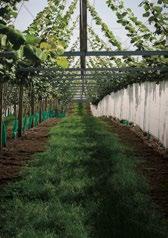
WerequestthatGovernments:Removecurrentlegislativebarrierstobusinesses employingandrewardingpeople, forexample, Fair Pay Agreements Ensure the RecognisedSeasonalEmployer(RSE) scheme is sustainable for both the Pacific and horticultureindustry, buildingonthesuccessof thepast16years Immigrationpoliciesandprocessesmustbe changedtomakeitmoreattractiveforpeople to come and work in New Zealand Vocationaltrainingschemesmustreflecthorticulture’s complexityandgrowamuchlargerbaseofpeople withtheskillstodrivetheindustryforward.
As Barry outlined in his column, “Large, populated countries such as the United States and the United Kingdom have much more competitive food markets with more players at wholesale and retail levels, easier serviceability and the ability to source year-round fresh produce from countries and counties that are close by, keeping prices down. [They have] enormous competitive entities, arising from more favourable business models and huge numbers of customers.”
Barry then went on to say, “What I think we can be fairly confident about is that our growers, who are struggling to get a reasonable price when supplying New Zealand’s supermarket duopoly, won’t end up with any more coin in their pockets if GST is removed from fresh fruit and vegetables. And after supermarkets have covered their costs of administering a more complex system, would there actually be any cost savings passed onto their customers?”
This sentiment has been echoed by Vegetables NZ chair, John Murphy, in his interviews on GST and food prices. John has welcomed the debate on GST, saying that Vegetables NZ “applauds any attempt by regulators to increase fresh vegetable consumption because of the health benefits.” However, Vegetables NZ is more supportive of “fit for purpose regulations that allow vegetable operations to thrive, by encouraging investment in vegetable production and eliminating hurdles that limit productivity.”
The need to remove unnecessary red tape and form filling came up time and time again at last month’s Horticulture Conference Week. While opposition Members of Parliament promised a lot and got great grower support, as we all know, reducing regulation is easier said than done, particularly when in New Zealand, central government regulation is overlaid by regional and local. Plus, reform takes decades and not years – for example, reform of the Resource Management Act is expected to take up to ten years to complete.
The aim of the Aotearoa Horticulture Action Plan is to double the value of horticulture to $12 billion by 2035. As the plan outlines, this can only be achieved through “policy settings that align and enable growers to do what they do best: invest into, develop, grow and market healthy nutritious food in a sustainable manner.”
HortNZ and the wider horticulture sector supports any move that would see an increase in the consumption of fresh vegetables and fruit. However, there are other complex issues that need to be addressed at the same time, which is why a more targeted approach is likely to be what is ultimately needed.

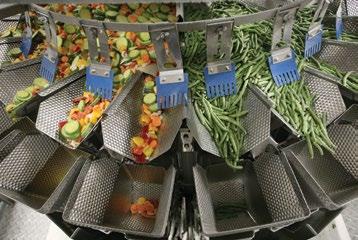
In the lead-up to the General Election, HortNZ will be redoubling its efforts to increase candidates’ understanding of commercial fruit and vegetable growing in New Zealand, and what must happen if we are to achieve our goals by 2035. Policies that are only about attracting votes and not about addressing the fundamentals holding industries like ours back are not going to ‘cut the mustard.’
Across industries and applications, we design specialised solutions.
Bringing together leading brands in processing, inspection and packaging equipment for the vegetable industries. Our solutions set the standard for yield, efficiency, and safety across a wide range of industries. Whatever your product needs, we can meet it with precision and passion.



Our industry’s inaugural Horticulture Conference Week (31 July to 4 August) was a rich smorgasbord of content, relevant to the entire industry in the context of the wider food and fibre sector and its dynamic nature. Held at Te Pae Christchurch Convention Centre, the
three conference programmes – the Horticulture Conference, the New Zealand Apples and Pears Conference and the Recognised Seasonal Employer (RSE) Conference – merged into one week of industry-centric presentations, speakers and content.

The rationale was to combine the three programmes for more impact. While themes were familiar – the environment, workforce, regulation, rising costs, competition and uncertainty – there were many fresh and thought-provoking perspectives, says Horticulture New Zealand chief executive Nadine Tunley.

“While no one was denying the challenges, the tone of the week was forward looking and positive. Engagement was often at its highest when politicians – present, aspiring and past – shared their perspectives and ideas with the audience. The message was our industry’s future is bright if we take a joined-up approach, informed by strategy, connection and two-way communication.”
Nadine also thanked the speakers, sponsors, exhibitors and other participants, “especially the growers who invested their time and money by attending and supporting the industry.”
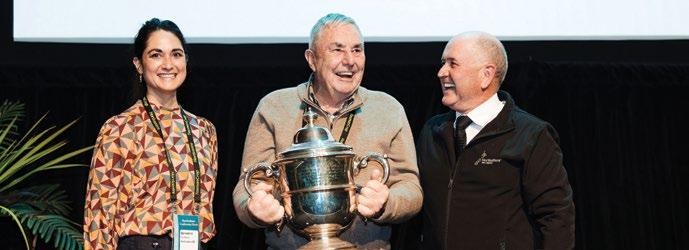
The horticulture Bledisloe Cup is awarded annually in recognition of an outstanding contribution to commercial growing in New Zealand over decades. Max Lilley first served at a national level in 1979, when he represented the Process Vegetables sector. He went on to hold several governance roles through the 1980s and 1990ʼs with the Horticulture Canterbury Growersʼ Society and Vegetable
and Potato Growersʼ Federation. Max was VegFed President when the Commodity Levies Act was introduced and led the organisation through a successful process. Today Max chairs the Growersʼ Trading Company Trust. When the company was sold to Farmlands, the proceeds were used to set up in a trust for the advancement of horticulture in Canterbury. Max also continues to be an active member of the Canterbury Growersʼ Association.
HORTICULTURE CONFERENCE WEEK WAS A RICH SMORGASBORD OF CONTENT, RELEVANT TO THE ENTIRE INDUSTRY IN THE CONTEXT OF THE WIDER FOOD AND FIBRE SECTOR
The Presidentʼs Trophy is awarded in recognition of passion for working on behalf of the horticulture industry, as well as a commitment to developing as a business leader and successful grower. Colin Jenkins has dedicated his life to the horticulture industry. He started his career as a market gardener. He went on to build an industry leader from a small, fledging trust, successfully navigating several challenges – like Psa and adverse weather events – over almost four decades. He is respected by his iwi as well as by his RSE (Recognised Seasonal Employer) whānau in the Pacific.



With Portacom’s range of hirable, temporary RSE Accommodation modules, you can scale up or down with your workforce no matter where you are.
So, if you are a Recognised Seasonal Employer seeking a reliable option, contact Portacom today on 0800 476 782 or visit portacom.co.nz/rse and mention NZ Grower
 The Presidentʼs Trophy 2023 winner Colin Jenkins addressed the sold-out gala dinner crowd
The Presidentʼs Trophy 2023 winner Colin Jenkins addressed the sold-out gala dinner crowd
The Environmental Award is presented in recognition of a person or organisation that has developed and implemented a sustainable environmental project, with identifiable benefits. This year’s winners are Rebecca and Mike Casey and Rachel and Euan White of Forest Lodge Orchard and Jesse and Matthew Malcolm of Southern Produce (So Sweet).
The Forest Lodge Orchard team have worked hard over the past four years to achieve climate excellence in food production. They run a 6ha high density cherry orchard in Central Otago that operates without burning any fossil fuels. Everything from irrigation to frost fighting, vehicles and tools are powered through New Zealandʼs renewable grid and through the power they generate and store using extensive solar and battery array.
Representing Southern Produce (So Sweet), Jesse and Matthew have been part of a catchment project driving change across different farming types in Southland. They have worked with the catchment group over several years to reduce the environmental impact of their operation through the use of information, in particular, about soil types.
Industry Service awards are presented to individuals who have gone beyond the call of duty by providing significant service to the New Zealand horticulture industry over many years. The 2023 winners are Grant McKay, John Jackson, Dr Jim Walker and Peter and Regina Bumseng.
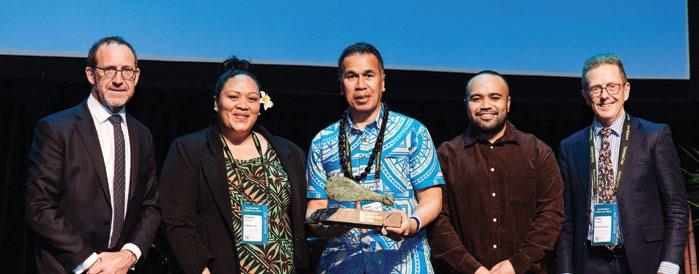




Grant McKay has encouraged many young people to take up a career in horticulture. He revived the Central Otago Young Grower of the Year regional final and has turned it into a high calibre event that attracts contestants and sponsors alike. Even though he has now stepped back, Grant is still mentoring young people in the industry.
John Jackson has been in the horticulture industry for nearly 50 years. He has been instrumental in improving seed quality and combating pests and diseases. John has concentrated his efforts in the process vegetables and potato industries, and today, still plays a governance role within the potato industry.


Dr Jim Walker has had a 45-year career participating in and leading scientific innovation in New Zealand. Although primarily associated with the apple sector, Jim has made significant contributions to the avocado, summerfruit, citrus and onion industries. Jim has used his scientific expertise to develop innovative tools and techniques around pest and disease management, enabling New Zealand to maintain its status as a competitive exporter.

Peter and Regina Bumseng received an industry service award in recognition for their work in supporting RSE workers and their families through the Strengthening Seasonal Workers Family Programme.

HortNZ’s Life Membership award recognise growers with long and dedicated service as office holders of HortNZ, an affiliated product group or grower association. This year’s recipients are Murray Stephens, Mike Arnold and Andre de Bruin.

Murray is based in Canterbury and has held a succession of governance positions in the vegetable, potato, process vegetable, grain and blackcurrant industries. Murray has a long association with the blackcurrant sector, as a founding member and chair of Blackcurrant NZ Cooperative Marketing. Today, Murray is an active member of the Canterbury Growers’ Association.
Andre has been involved in vegetable industry governance for more than 25 years, at both regional and national levels. Andre’s work over this time has had a massive impact on the kumara and wider vegetable industry. Andre has a strong philosophy of making sure the next generation of growers and industry leaders are successful through mentorship.
Mike continues to be a strong advocate for the training and development of people in the vegetable sector. Mike is a past director of HortNZ and chair of the Canterbury Growers’ Association. Mike is currently on the Brassica Crop Advisory Group for Vegetables NZ.

When it comes to glyphosates, for generations Roundup has been the standard by which all others are measured. The latest generation Roundup Ultra®MAX with the superior surfactant TRANSORB II® is no exception.
Every drum of Roundup Ultra®MAX is manufactured to the highest standards.
Powerful TRANSORB II surfactant system delivers fast uptake and translocation into weed roots.

The powerful surfactant system in Roundup Ultra®MAX ensures rapid penetration into the plant, delivering fast brownout and quicker translocation to the roots.
Roundup Ultra®MAX sprayed paddocks can be grazed (except where ragwort is present), cultivated or drilled just one day after spraying for annual weeds, and three days for perennial weeds. High load, low viscosity and low foam formulation. Available in a range of pack sizes.
GET THE SPRAYOUT RIGHT FIRST TIME, EVERY TIME

Horticulture is the future for sustainable food production in New Zealand and the next few decades will see exciting growth and development within the industry, believes Tony Howey, blackcurrant grower and retiring Horticulture New Zealand board member.

“Horticulture is at a similar point to that of the dairy industry in New Zealand 30 to 40 years ago. There is a lot of land on which horticulture could sustainably grow food for even more people both domestically and internationally,” says Tony who is stepping down from the HortNZ board after nine years of service.
“Now is an exciting time to be part of the horticulture industry. I’m looking forward to seeing what it looks like in 10 to 20 years’ time.”
Tony acknowledges that not all growers may share that optimism right now. “It can be difficult to stay positive, especially for the many growers who have suffered through recent floods. But time does heal. It is important to look forward through the windscreen rather than in the rear vision mirror. Doing so helps you take small steps forward.”
Optimism and a belief that they can turn their tough situation around and that next season will be better is an important characteristic among growers, he says.
As well as natural disasters there are other significant challenges for the industry. “Gaining consents and continuing to grow fruit and vegetables is becoming more and more complex, and the challenges have increased exponentially during my time on the board.
“HortNZ plays a vital role in the industry and if it’s doing its job well, is often almost invisible to growers. The role of HortNZ is to enable growers to get on with the job they do best; which is growing food.”

Behind the scenes, HortNZ works on the issues impacting growers’ businesses including increasing regulation and compliance costs, consumer demands for sustainably produced food, biosecurity threats, attracting people into the industry and climate change.
During recent natural disasters, including those caused by Cyclone Gabrielle, HortNZ played a vital role in co-ordinating relief efforts and advocating on behalf of growers for government support packages.
“The industry highlight for me was before my time on the board when the fruit and vegetable sectors came together to form HortNZ,” says Tony.
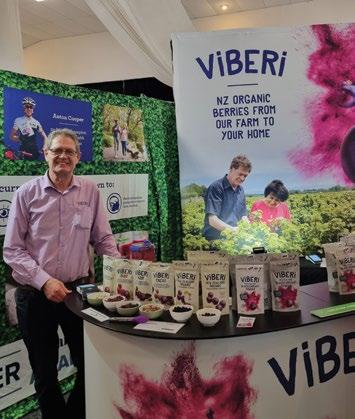
Book your tickets now!
4th October: Competition day
5th October: Leadership panel and awards dinner

PIA Events Centre, Pukekohe
FIND OUT MORE: younggrower.co.nz
In 2005 HortNZ was formed out of the merger of the New Zealand Vegetable and Potato Growers’ Federation (Vegfed) and the New Zealand Fruitgrowers’ Federation (NZFF).
“That merger was important because the major issues affecting the industry are common to us all. It is really important we came together to have a collective voice and work out solutions together. It’s also important that we are still united and continue to advocate and support growers, providing value for the industry.”
Growing food was always going to be the career of choice for Tony, who grew up on a mixed arable, sheep and beef farm in Canterbury with three brothers and a sister.
“The family farm was on heavy clay soils, not suitable for horticulture, but I was brought up with machinery and livestock and that’s where my love of agriculture started.
“There’s something almost primeval about growing food, and after raising children, providing food for others is the most important career in the world. Horticulture is a good industry to be in. It might not be the best from a financial point of view but it’s about growing great food, serving others and feeling good about what you do.”
HortNZ’s new strategy and vision “Healthy food for all forever” aligns exactly with the vision Tony and his wife Afsaneh have for their own business ViBERi organic blackcurrants, which are grown on a certified-organic family orchard just out of Pleasant Point, two hours south of Christchurch.
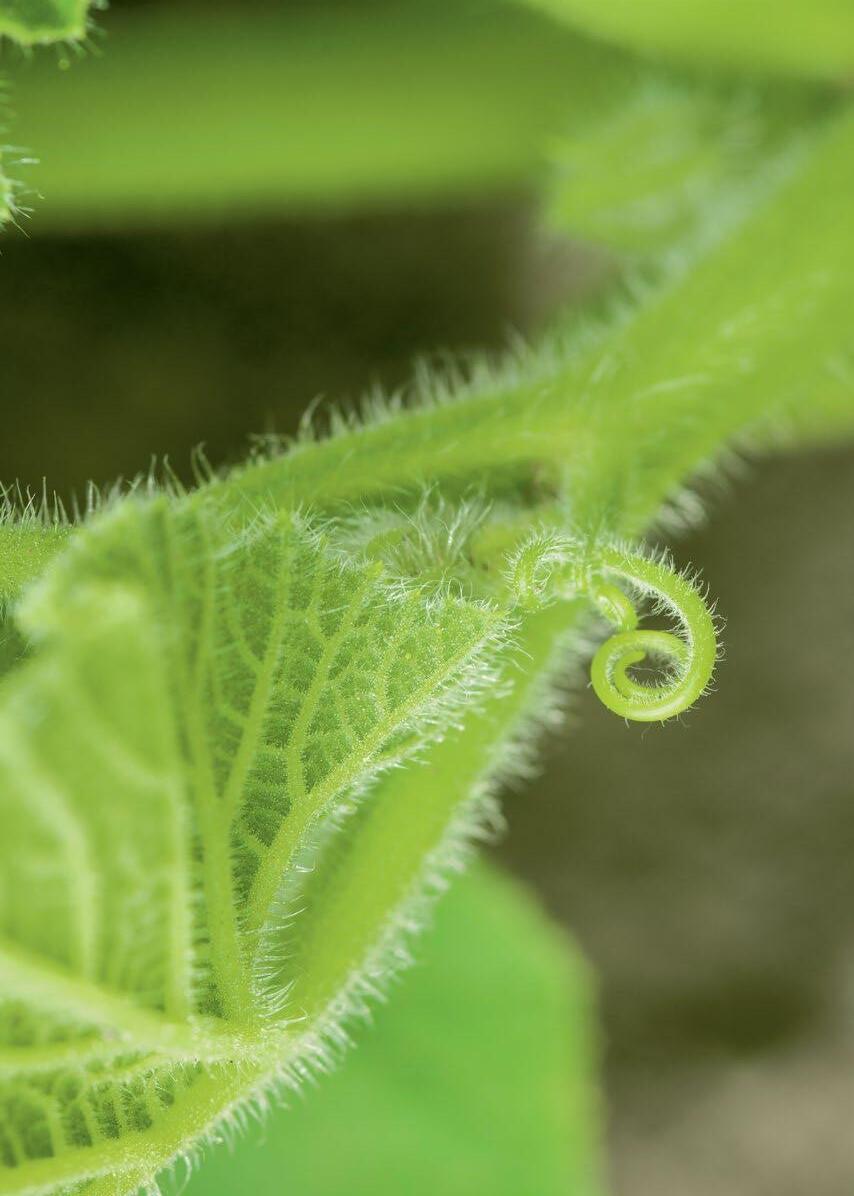
“Healthy food for all forever is the ‘why’ for the New Zealand horticultural industry and the ‘why’ for our own business too which is growing nutritious, sustainable and affordable food in an act of service to the domestic and international markets.”
The couple grew peas, potatoes, onions and carrots on fertile, irrigated soils before buying a blackcurrant farm in 2004. “The operations became too big and too spread out, so we made the decision to sell the arable and vegetable business and concentrate on blackcurrants as a semiretirement project.
“Another reason was that Afsaneh was looking for a change to what she was doing. Afsaneh is a born saleswoman and in ViBERi we were able to combine our skills to develop what we had always wanted; a branded food business which is integrated from paddock to plate, from the grower through to the consumer.”
Service is at the heart of Tony’s philosophy and is the reason he has dedicated so much of his time and energy to many community and primary industry related boards and committees.
“Financially our business would probably be better off if I hadn’t been involved in so many organisations, but it’s not always about the money. I’m a ‘developer’ by nature and like to see development happen and leave something better than when I started.”
While studying at Lincoln University, Tony was named its farmer of the year. Later he was awarded Nuffield and AGMARDT scholarships, which he says helped develop his personal and business skills.
“I would encourage young people to apply for these types of awards while they have the energy to put into them and the opportunities to benefit from the experience. It makes you reflect on your business and what drives it and your continuous striving for improvement. The experience also widens your horizons and opens your mind to new possibilities and opportunities and the chance to see how things are done in other parts of the world.”
Once he retires from the HortNZ board Tony is looking forward to spending more time with his four grandchildren, enjoying tandem biking with Afsaneh, working in the family business and continuing his involvement in community organisations, including Venture Timaru’s board of directors.
“I WOULD ENCOURAGE YOUNG PEOPLE TO APPLY FOR [GROWER] AWARDS WHILE THEY HAVE THE ENERGY TO PUT INTO THEM.”
Vivando® inhibits powdery mildew spore germination and penetration of host plant tissue by disrupting growth and development of the germination tube and appressorium.
Vivando’s novel and advanced mode of action, with no cross-resistance to other chemistry, provides robust protection of grapes, pumpkins and winter squash.
When used in pumpkins and winter squash, Vivando is a flexible partner for powdery mildew control programmes and can be used to up to 14 days before harvest.

An exciting trial is underway that is melding Pasifika cultural leadership and traditions with the latest contemporary safety thinking (Safety II) to reduce injuries to Pasifika Recognised Seasonal Employer (RSE) workers and workers from all ethnicities, to benefit the whole of the country’s horticulture industry.

Guided by a steering group of Pasifika cultural and safety experts, alongside myself, the two-staged project started with a trial at Apata Group Ltd in Tauranga with the company’s summer RSE crew that ran across a fortnight in April 2023. Those learnings are now informing the second phase of the project consisting of full-scale pilots at two further growers in the Bay of Plenty and Auckland.
It is hoped that learnings from this project will not only improve the safety and welfare of workers by giving them a voice and a shared responsibility in making safety improvements, but also benefit the whole of industry through team collaboration to uncover opportunities for operational improvements.
The Safety II approach, based on internationally recognised safety science, seeks to reframe the pursuit of safety in our workplaces based on an understanding that safety is an emergent capacity to enable things to go right across varying conditions. This capacity is referred to as ‘resilience’.
Where previously behavioural science approaches saw workers as a problem to be controlled, the new science sees workers as highly adaptable actors who balance unpredictable demands and constraints and make (almost always good) decisions to keep our systems operating.
Each year, around $15 million is paid out in horticulturerelated ACC (Accident Compensation Corporation) claims. Lumbar sprains, cuts to hands and fingers, back or shoulder injuries and eye injuries are the most common claims. Many workers report feeling levels of stress, which represents an invisible yet important psychosocial risk. Workers in our industry are often incentivised to work longer or quicker than is safe during peak seasons.
That’s obviously not an ideal situation – however you unpack it. Many workers are away from home and frequently the breadwinners for their families and communities back in the Pacific Islands – and here in
Aotearoa, growers with tight timeframes and economic imperatives too, can ill afford to be short of workers to get the job done.



After Horticulture New Zealand and ACC’s Grow Home Safe project flagged this as an area of concern, the idea of a cultural competency project, drawing on a Safety II approach, to problem solve the industry’s injury concerns was conceived. The idea is to create cultural safety to support operational teams as they engage with the concepts to maximise the results.
Within the Apata experiment, the safety and operation teams were reviewing reports of manual handling injuries and were motivated to reduce them as a priority. The wellbeing of workers was of primary concern, and the downtime during peak season created production risks requiring attention. With approximately six shifts involved in the high-volume packing and shipping effort during harvest, a team that was safe and performing to a high standard was essential.

There’s a temptation to jump to the conclusion that the injuries are simply down to language differences and the seasonal nature of the work, but in truth the reasons may be more complex and nuanced than imagined. That’s where Safety II comes into its own with its focus on understanding how work is done in practice from the workers’ perspective, rather than solely relying on the insights of management.
A ‘Learning Team’ was trialled with the Samoan workers at Apata’s packhouse. As it turned out, Apata had recently upgraded its processing facilities using the latest technology. Being the first season using it, understandably there were teething problems to iron out. Rather than focus on why the injuries were occurring, we sought to get insights into what was helping and hindering their performance and how they were achieving success despite the demanding conditions.
There’s a challenging bridge to cross to establish a high level of trust from Pasifika workers (and the wider horticulture community) – especially when they are unaccustomed to Aotearoa and our ways – to enable them to feel comfortable and culturally safe enough to share their valuable insights with us. That underlines the importance of a Pasifika steering group that can guide, lead and support this project.
Hans Key is a much respected Samoan elder and safety expert with WorkSafe. He emphasises the importance of allowing the leadership of this project to have a Pacific lens. “Workers from the Islands are not just a labour force as they come in and out. They appreciate the work they do in New Zealand and pride themselves on their work ethic,” he says.
“Through this project we want to instil in the teams awareness, but more importantly, bring forth the innovative capabilities of the teams to contribute to the workplace, give insights and suggestions, and contribute more of the skills and talents they bring with them from their home countries.”
Heath Dibble, the line manager for Apata’s kiwifruit packhouse, who has day-to-day involvement with the Pasifika workers says, “it’s been awesome, an amazing process, and the team has been really open and helped us identify things we were not previously aware of.”

He’s positive about what the project has to offer the industry. “The principles of looking at the positives first really worked. The guys opened up about the great things they were doing to keep themselves and others safe. They then thought deeper around where we could improve,” says Heath.
“We discovered these guys have skill sets, outside of their daily packhouse roles, that could contribute to the problem solving needed every day. Apata is keen to ramp up the Learning Teams methodology across other teams to continue to bring out the best in our teams.”
That’s a view backed up by Keith Bardwell, Apata’s point of contact for this project and the company’s health and safety advisor. Excited about carrying on with Learning Teams, and the mix of cultural and Safety II methods that provides deeper understanding of what’s really going on at work, he admits to finding out information about the reasons behind the injuries that he wasn’t previously aware of.
“I’ve been happily surprised to discover the work teams were being very proactive in responding to the
challenges associated with the new upgrades to the production line. They were taking a lot of initiative, and when supervisors were tied up troubleshooting technical problems, the teams were creating flexibility by swapping workers across teams to ensure production continued to run smoothly,” says Keith.
“We found out that the team weren’t lifting too much because they were trying to be heroes, they simply ended up having to keep up with the production pressures resulting from the line changes, and were doing their best to adapt and do the right thing.”
“On a personal note, the Learning Team process has also bridged the cultural gap between myself and the teams,” says Keith. “I now find myself stopping for a chat with the guys regularly and gaining more insights into how they’re working on a day-to-day basis. This kind of trust will help us make further improvements together next season.”
For anyone keen to learn more about the project, or volunteer time and resource towards the pilot, get in touch with: Matt Thorn, HortNZ project manager matt.thorn@hortnz.co.nz

There’s a challenging bridge to cross to establish a high level of trust from Pasifika workers

Upper North Island Alan McKee, Mobile: 021 956 701, Email: alan.mckee@tnseeds.com
East Coast & Manawatu Graeme Jackson, Mobile: 021 396 359, Email: graeme.jackson@tnseeds.com
Ohakune & Horowhenua Kathryn Wells, Mobile: 021 475 482, Email: kathryn.wells@tnseeds.com
South Island David Stewart, Mobile: 021 352 764, Email: david.stewart@tnseeds.com
Auckland/Protected Cropping Ingrid Ennis, Mobile: 021 435 493, Email: ingrid.ennis@tnseeds.com
Freephone: 0800 TERRANOVA (0800 837 726)

The passing of the new Natural and Built Environment Bill (NBA) legislation which protects and enhances the growing of fresh fruit and vegetables and increases food security in New Zealand has been greeted with relief by horticulturists throughout the country. ELAINE FISHER reports.
“The general public would be shocked to know how difficult it has become to be allowed to produce fresh healthy fruit and vegetables in this country,” says Jay Clarke of Woodhaven Gardens in Horowhenua.

“The passing of this bill is a fantastic outcome for all fruit and vegetable growers in New Zealand.”
Jay applauds the work of Horticulture New Zealand, Vegetables NZ and individual growers and orchardists
who, for three years, have advocated for changes to the former Resource Management Act (RMA) to enable the continued growing of fruit and vegetables in this country.
Under the former legislation some growers faced prosecution if they grew vegetable crops in certain areas, but they could grow maize to feed cows on that land, he says. “That is some of the madness growers have been dealing with, and among the reasons for an exodus of growers from the industry.”
Government decisions had taken for granted that New Zealand consumers would always have enough fruit and vegetables without planning for it
Jay says the new NBA legislation is now aligned with community sentiment. “The public is supportive of New Zealand growers who are leading the world in growing fruit and vegetables in the most sustainable way possible to provide reasonably priced fresh food for consumers.
“What happened during Covid-19, Cyclone Gabrielle and the Auckland floods really shone a light on what the industry has been saying for a long time – that we need a sustainable geographically diverse growing network across this country to be able to provide food for New Zealanders. If we don’t have that, there will be shortages of fruit and vegetables on shelves.
”Restricting the productivity of growers and prohibiting the use of parts of the country in which growing can happen makes no sense, but has been the position of some regional councils for far too long, Jay says.



“This new legislation is a step forward in saying that it’s really important mahi that growers in New Zealand are doing to provide products which make people healthier the more of them they consume.”






WE WELCOME CHANGES WHICH MAKE IT EASIER TO ACCESS FERTILE LAND AND WATER TO GROW NUTRITIOUS FRESH FRUIT AND VEGETABLES FOR OUR FELLOW KIWIS AND OUR CONSUMERS AND CUSTOMERS IN EXPORT MARKETS.
THE DEBATE ON REMOVING GST ON FRESH VEGETABLES AND FRUIT HAS HIGHLIGHTED THE CHALLENGES THAT AN INCREASING NUMBER OF NEW ZEALANDERS FACE WHEN TRYING TO EAT HEALTHY, FRESH FOOD.
JOHN MURPHY, VEGETABLES NZJay says that while the National Policy Statement for Highly Productive Land recognises the significance and importance of soils, if you can’t get permission to cultivate those soils and provide water and nutrients to your crops you can’t grow food. “The soil itself is only one part of the equation.”
“Across the country, many growers require resource consent, however they were often, under the current framework, unable to achieve that even if they were operating at the recognised best practice standards.”

Currently the ‘environmental lens’ applied to legislation has a large focus on nitrates at the expense of the broader picture, Jay says. “We know growing fresh fruit and vegetables is the most environmentally efficient form of food production, as the growing systems are extremely efficient in converting nutrient and water into food, and do so on far smaller areas of land than other farming systems.
“When the freshwater legislation was written it didn’t take into account efficiency of food production systems but just looked at the total impact per hectare, and that has been leading us down the road of promoting the least environmentally efficient food production at the expense of the most efficient.
“The NBA will force regional and district councils to have specific rule frameworks which work for fruit and vegetable growers and promote excellent practices.”
That, says Jay, is in line with what growers want. “I have yet to meet a fruit or vegetable grower who doesn’t want to do their best to produce healthy food with the lowest overall impact on the environment.”

Some credit for the NBA’s provision around fruit and vegetable growing must also go to the Environment Minister David Parker, says Jay. “I would like to personally thank Minister Parker who picked up the baton on this for us and did something about it. Over the years there has been a lot of talk about change but not much action. Minister Parker saw the importance of ensuring New Zealanders retained access to healthy New Zealand grown fresh fruit and vegetables, and helped our industry gain a positive outcome with this legislation.”
Trudi Webb of Webb’s Fruit, Cromwell agrees the provisions of the new legislation are good news for growers.
“This is a great decision for our industry,” she says. “Growers are hugely passionate about what they do; growing fresh fruit and vegetables for all New Zealanders. [For] fresh fruit and vegetable supply to be recognised in the NBA is a great result. We greatly appreciate the work that Michelle Sands of HortNZ and her team have put into this.”
Rod Gibson, managing director, T&G Fresh, also acknowledges the importance of the new act.
“We welcome changes which make it easier to access fertile land and water to grow nutritious fresh fruit and vegetables for our fellow Kiwis and our consumers and customers in export markets,” he says.
“Our ability to continue to meet the demand for New Zealand grown fresh
produce relies on having the right framework and conditions to provide optimum results, and location plays a big part in this equation.”
Blenheim garlic and shallot grower and Vegetables NZ chair John Murphy says vegetable growers welcome any change in regulation that makes it easier for them to grow fresh, healthy vegetables because of their health and wellbeing benefits.
“The debate on removing GST on fresh vegetables and fruit has highlighted the challenges that an increasing number of New Zealanders face when trying to eat healthy, fresh food,” says John.


“Increasing growers’ ability to grow and expand by improving access to land and water would improve food security and help increase supply and therefore the availability of fresh vegetables across New Zealand.”
Though its footprint is small compared to pastoral farming, horticulture is a highly productive use of land and it requires slightly different rules under

I HAVE YET TO MEET A FRUIT OR VEGETABLE GROWER WHO DOESN’T WANT TO DO THEIR BEST TO PRODUCE HEALTHY FOOD WITH THE LOWEST OVERALL IMPACT ON THE ENVIRONMENT.
JAY CLARKE, WOODHAVEN GARDENS
THIS IS A GREAT DECISION FOR OUR INDUSTRY.
TRUDI WEBB, WEBB’S FRUIT
which to operate. Under the former Resource Management Act, some decisions by regional and district councils have sometimes had unintended consequences. In many cases rules restricted crop rotation. The way water was allocated has not been reliable enough for the production of horticultural crops, says HortNZ general manager strategy and policy, Michelle Sands.
“It is important that the planning environment provide flexibility and options for farmers and growers,” she says. “We need to look to the future, not just the past when deciding how to manage natural resources.”
As the world transitions to a lower emission economy, it will create more demand for plant-based food and New Zealand has a favourable climate and productive land able to meet some of that demand.
“Fresh fruit and vegetables are fundamental to human health and wellbeing. It’s great to see this fact of life reflected in planning legislation that will influence resource decisions across New Zealand for years to come.”
For more information about the Natural and Built Environment Bill, visit: https://environment.govt. nz/publications/resource-management-reform-thenatural-and-built-environment-act/

The Natural and Built Environment Bill that the national planning framework must enable the supply of fresh fruit and vegetables –an explicit recognition of the importance of food security, says Horticulture New Zealand general manager strategy and policy

Michelle Sands.
“This recognition will ensure that the growing of fruit and vegetables is a key focus in planning decisions across New Zealand.”
Since 2020, HortNZ has advocated to achieve this outcome, seeking grower feedback and support, putting forward submissions on the early versions of the new legislation and speaking to select committees. By identifying how aspects of the legislation could pan out, HortNZ communicated with decision-makers to suggest ways to avoid unintended consequences.


“New Zealand is a geographically isolated country, which can make the importation of some fresh fruit and vegetables difficult. we will continue to grow foods for export, we also need to make sure New Zealand is resilient in the quantity and variety of fresh fruit and vegetables we produce for ourselves.
“That may seem like common sense, but it has not been part of planning decisions to date. It has been taken for granted that New Zealand would always have enough fruit and vegetables to deliver to New Zealand consumers without having to plan for that.”
Covid-19 and this year’s ongoing adverse weather events have led to the country’s consumers being faced with supermarket shelves empty of fresh produce.
“To ensure resilience during such events, we have to have growing areas in the north, south, east and west and we need infrastructure and transport routes to enable movement of fresh fruit and vegetables to consumers.”
IT IS IMPORTANT THAT THE PLANNING ENVIRONMENT PROVIDE FLEXIBILITY AND OPTIONS FOR FARMERS AND GROWERS. MICHELLE SANDS, HORTNZ
pest management
extremely high in glucosinolates
microbiology builder
highly vegetative
large light intercepting leaves
strong tillering
large green matter content above ground green manure
Slow bolting, bi-annual radish
proven results in the reduction of Sugar Beet CystNematode (Heterodera schactii)
erosion control
proven results in the reduction of Clubroot (Plasmodiophora brassicae)
can be used as forage
water retention
beneficial insects
fat tap root combined with strong lateral roots which exploit horizontal fissures and nutrient scavenging ability
proven results in the reduction of RootKnot Nematode (Meloidogyne spp) suppression
proven efficiency in clubroot control a cover crop that will increase soil quality by improving the biological, chemical and physical soil properties.
MAXIMISING SOIL POTENTIAL


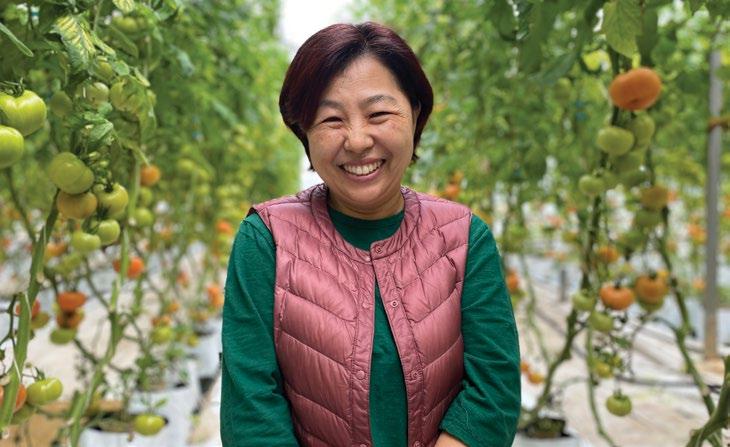
Nestled down a long driveway in the heart of Waiuku, southwest of Auckland, lies the Kim family’s horticulture operation.
Jungeun (Jiny) and her husband Minju have been growing tomatoes in Waiuku since 2019, moving from their first tomato-growing site in Helensville, northwest of Auckland. They grow the Daniela variety of tomatoes along with some courgettes.
“My husband worked for another tomato grower for four years before he started his own: he had experience growing tomatoes but he didn’t know all the techniques needed for growing. We failed that first year,” Jiny says.
“We were lucky to move to this [Waiuku] site, leasing it from a family friend. The Helensville site was much smaller and we have much more potential here.”
There are five greenhouses on their almost 4000 square metre site, however, Cyclone Gabrielle caused significant damage to one of the houses, removing the roof and leaving them with a large repair cost. Around this time the Kims also lost their one employee to the construction industry, which could offer a higher pay rate. So they have scaled back to four greenhouses, with both Jiny and Minju working for the business full-time.
Minju grew up in the countryside in South Korea, and longed to bring their children up in the countryside or a smaller town. He is passionate about horticulture despite its many challenges.
Jiny worked in the Israeli embassy in Seoul, South Korea, for many years before moving to New Zealand, where she met her husband more than 20 years ago. Here she raised her young family, later becoming an early childhood education teacher. With no background in horticulture, Jiny joins dozens of other highly educated Koreans working in horticulture in New Zealand.
She speaks frankly about the difficulties the couple faced in their first few years growing tomatoes, citing numerous challenges due to outdated facilities, limited knowledge, information and networking opportunities in the tomatogrowing industry.
“However, these difficulties ignited a strong passion within me for growing tomatoes. I discovered that I truly enjoyed the daily growth of tomato plants and how they responded to various techniques I implemented.”
Now, five years on from taking up horticulture full-time, Jiny is passionate about connecting the Korean community with the wider horticulture industry.
“I realised that growing is not just about financial gains but also about giving back to the community in many ways. Both my husband and I take great pride in that. As a Korean-speaking woman with a different background, in horticulture, I strongly believe that I bring a fresh perspective and valuable, creative ideas to the industry.”
Twenty years ago there were about 60 Korean families working in horticulture in the wider Auckland area, with 40 of those families growing tomatoes. Jiny says there are now around 35 families after some retired, and with many more likely to retire in the next five to ten years.

“When I came to the south Auckland area, I noticed there were many Korean growers with more than 20 years of horticultural experience, but they had no connection with TomatoesNZ or Horticulture New Zealand. So they just

grew tomatoes by themselves, and while they have a close-knit community, they didn’t have access to any other support.
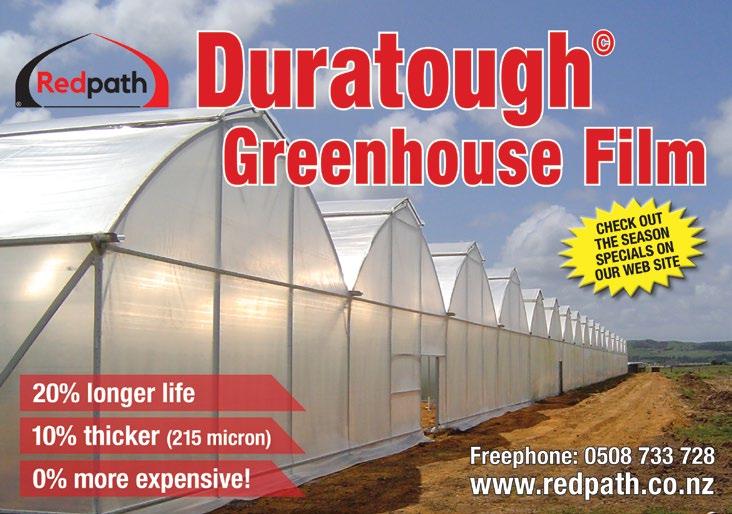
“When we first came here, with my lack of growing background, a lot of growers from the Korean community came to us to help repair things and teach us how to grow tomatoes. But there were huge gaps in their knowledge due to the language barrier. They might get emails about NZGAP or from HortNZ, but not many people could read or understand them, and digest what was going on.”
Jiny was able to help her helpers in return, passing on information from HortNZ.
During the first national Covid-19 lockdown, the Kims were selling tomatoes through MG and received a latenight email outlining the controls they needed to take in order to keep supplying MG under Covid-19 restrictions.
“I suggested that they need to send every single word from the email in Korean to the Korean community: they contacted me back and asked me to translate it. I thought ‘Oh no!’ because English conversation is different from the language in the document, and I didn’t want to make any mistakes. A friend’s son was graduating in horticulture from Lincoln University so I asked him to support me and help
THERE ARE FIVE GREENHOUSES ON THEIR ALMOST 4000 SQUARE METRE SITE
translate it. With his support, we were finally able to send that information in Korean to other growers.”
Jiny says adapting to government regulations, customer demands and environmental challenges can be hard to practice every day, but even harder for growers with limited access to information and networks due to language barriers, financial constraints and labour issues.
“I am particularly keen on being a voice for small to medium-sized tomato growers, as I am fully aware of the difficulties we face in this challenging environment.
“Smaller growers are very, very isolated. So as a board member, I want to be a channel to connect to smaller growers. I want to foster a better sense of belonging to HortNZ and to feel better connected.”
Having worked in horticulture both northwest and south of Auckland, Jiny has been able to use her networks to create a group chat of growers from the Korean community on a mobile app. It is a good way of circulating information from TomatoesNZ and HortNZ to the Korean community. And while people don’t often reply, Jiny knows that many growers are seeing her messages.
“I am nearly the youngest grower in our Korean community, and often our older growers are struggling with the computer side of things in particular.”

The horticulture industry offers some great conferences, seminars and workshops, but often access to these is hindered by a lack of technological knowledge for something as simple as registering interest or attendance. Jiny hopes that growers will be confident enough to ask for help and upskill themselves in order to take advantage of some of the great industry knowledge that is available.
In August, Jiny attended the Horticulture Conference Week in Christchurch, particularly for the Vegetables speaker
60 KOREAN FAMILIES WORKING IN HORTICULTURE 40 OF THOSE FAMILIES GROWING TOMATOES
THERE ARE NOW AROUND 35 FAMILIES

20 YEARS AGO NOW
sessions and TomatoesNZ Annual General Meeting. Horticulture Conference Week also included Talanoa, the Recognised Seasonal Employer (RSE) Conference 2023.
“It was amazing. I feel really connected with horticulture after attending the conference. However, while smaller growers don’t use RSE workers, more information about holiday workers or backpackers would be great. We are under the same horticulture or tomato-growing umbrella, but smaller growers face different challenges from the big growers.”
While the challenge of securing enough labour remains a common one across the industry, small to medium growers often have different energy needs and are highly educated people in different fields, learning horticulture from scratch.
“The starting points of being a grower are often very different for our small, local growers. It can be a challenge to obtain industry information and improve growing practices.”
Jiny hopes more small growers will gain the confidence to step out of their comfort zone, connect with the industry and share knowledge from other growers.

Any Korean-speaking greenhouse growers who want to be put in touch with Jiny, please email TomatoesNZ business manager Dinah Cohen: info@tomatoesnz.co.nz

Next year’s update to the New Zealand Good Agricultural Practice (NZGAP) will make the system easier to use for growers of various crops, business sizes and complexities. Share your feedback with the team behind the review and help make NZGAP Version 7 clear, concise and effective.
As it marks its 25th anniversary this year, the New Zealand Good Agricultural Practice (NZGAP) has undergone a significant evolution. Originally focusing on the certification of safe fresh produce, NZGAP has developed into a comprehensive assurance framework. This framework now plays a crucial role in facilitating market access and regulatory compliance for the horticultural industry.
NZGAP serves as a valuable resource for growers, enabling them to not only access domestic and international customers but also to uphold their social licence to operate. By aligning with regulatory and community expectations, growers can access markets and maintain public trust.
NZGAP continues to expand its array of certification options and recognitions, providing New Zealand growers and horticulture businesses with an effective tool to navigate compliance challenges.
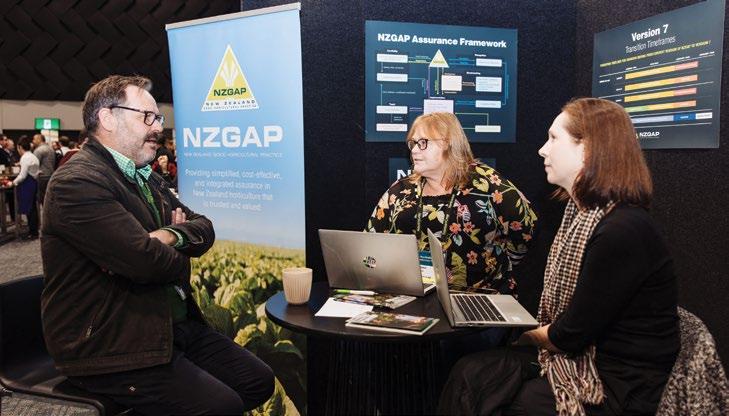
In the ever-evolving landscape of compliance, it is important that NZGAP remains up to date and can adapt to be in a strong position to best serve New Zealand growers and operators in the horticultural industry.
To remain at the forefront of market and regulatory expectations, NZGAP is undergoing a review of its base standard. The review seeks to ensure that both market and regulatory standards can still be effectively met, maintaining a seamless approach. The goal is to establish clear and easily comprehensible requirements that ultimately contribute to good agricultural practices.
Navigating market and regulatory requirements can be a complex and time-consuming process for growers. NZGAP intends to continue to minimise duplication and compliance burden whilst providing certification options that suit individual businesses. The review will result in the following certification options that will all be recognised under the Food Act, ensuring that growers with NZGAP certification can meet customer expectations and their obligations under the Food Act.
• NZGAP-local: This certification option is designed for businesses seeking recognition within the local market. It caters to growers who predominantly supply produce within New Zealand.
• NZGAP-GGE (GLOBALG.A.P. Equivalent): For those who intend to supply markets beyond New Zealandʼs borders, this certification option aligns with the internationally recognised GLOBALG.A.P. standard.
• NZGAP-GFSI (Global Food Safety Initiative): This option will become available once NZGAP gains recognition to GFSI. As with the recognition of GLOBALG.A.P., this will be a testament to New Zealand growers producing safe food that meets international benchmarks.
A cornerstone of NZGAP Version 7 is its commitment to clarity and ease of understanding. While there will be some change in requirements, the primary focus is not to set the bar higher but to enhance clarity and conciseness. NZGAP aims to offer adequate information to outline expectations whilst enabling individual businesses to determine how they meet these requirements. The objective is to allow growers to focus their efforts on the implementation of good agricultural practice rather than deciphering requirements. In many instances, as we’ve seen in the past, there will be more than one way to demonstrate how requirements are met.

NZGAP is designed not just to meet evolving market expectations, but to embrace the diverse needs of our industry. The review of the NZGAP standard will set the scene for additional development work going forward to support New Zealand growers to meet future compliance obligations and challenges.
Very hot red chilli. Naturally strong plant with good setting ability, thick walled fruit 110-140mm and averaging 15-20g, great yield.

Brilliant green oak for hydro production. Beautiful presentation. Heavy weight. Holds well, easy to cut and handle. Vigorous. Year round production. Bl 1-39, Nr:0
Double red oak for production in field or hydro. Good green to red contrast. Full voluminous head, with medium fine lobed, glossy leaves. Year round production. Adaptable variety. Good uniformity. Bl 1-31, Nr:0, LMV

The timeline for NZGAP Version 7 is determined by the standards under which it is seeking recognition. The GLOBALG.A.P. Equivalent NZGAP Version 7 needs to be submitted in early 2024, shaping the overall review timeframe. We intend to have the review complete by then.
We are seeking feedback for the base NZGAP standard from across the horticultural sector for the development of NZGAP Version 7. The Social Practice and Environment Management System Add Ons are not part of this review. Recently, we had a stand at the Horticulture Conference in Christchurch where we took the opportunity to get feedback from a variety of attendees.
We are establishing Technical Advisory Groups to assist in the review of the standard in addition to feedback from other stakeholders. As the NZGAP standard touches upon various crops, business sizes and complexities, feedback from growers, wholesalers, retailers, transporters, packhouses, auditors, product groups and any other stakeholders is invaluable.

If you can provide feedback on: what would make the certification process easier for you aspects of the checklist that are difficult to understand or not clear or anything else you think is relevant

Please get in touch with either:
kate.mcdermott@nzgap.co.nz or melanie.dingle@nzgap.co.nz
When it comes to effectively fighting nematodes, you need a nematicide with real teeth. Try NIMITZ®, the powerful, effective and easy-to-apply new way to conquer root-knot nematode, root lesion and potato cyst nematodes, that also leaves your soil in good condition.

An innovative nematicide containing fluensulfone which combines proven efficacy against plant parasitic nematodes with a very favorable toxicological profile. A top performing nematicide providing excellent performance.
Get NIMITZ power today, contact your local ADAMA Commercial Manager or visit Adama.com

One weather event after another has had a devastating effect on many areas of the Gisborne region and, as KRISTINE WALSH reports, the strain has been building in its people, too.
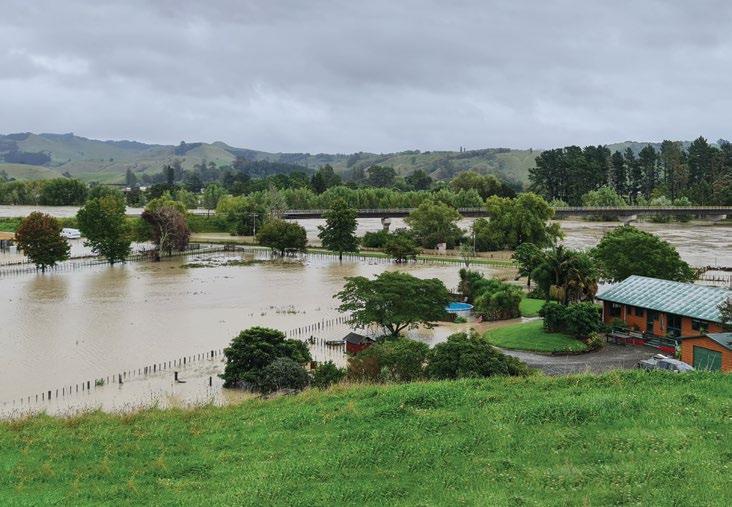
Hampered by her fractured foot strapped into a moon boot, Vicki Crosswell watched from her home on the outskirts of Te Karaka as dead stock, hay bales, and even a fridge barrelled down the Waipaoa River, eventually leaving her stranded by a surrounding moat.
“There was a lot of water, a lot of damage, and one drenched alpaca who had to take a very big swim,” she says of her experience during Cyclone Gabrielle.
“Being on a bit of a rise I was lucky to keep my home but it was very frightening and pretty bloody close.” It is an experience Vicki has taken into her role as co-ordinator for the East Coast Rural Support Trust. Perhaps even more important, though, is her more than 10 yearsʼ experience working with victims of all kinds of crimes and adverse events.
Itʼs work Vicki is passionate about even if it is not quite what she signed on for, having accepted the job in early January – before Cyclone Hale, before Gabrielle, before the months of relentless rain that has turned the region into a big, sodden bog.
“So for me it was straight out the frying pan and into the fire,” she says. “Itʼs just lucky I love a challenge!”
The ‘frying pan’ Vicki refers to is her 11 years working for Police Victim Support. Though her official territory was the Wairoa and Gisborne regions, it had in recent years taken her south – where she worked until the end of last year with those affected by the Christchurch mosque attack – and west, where she was part of the response to the Whakaari White Island eruption.
But trauma is trauma, says Vicki, regardless of what caused it.
“However, there is a difference with the impact of the devastating weather events we have seen in and around Gisborne,” she says.
“Because there has been one thing after another, the mental strain can build without the person really being aware of it. Like a grower who has lost their crop for the third time. They may have coped the first time, and the second – thatʼs just farming – but everyone has their limit.”
The key to it is working with people face-to-face, she adds.
“There is a lot that people wonʼt tell you on the phone that might be more apparent once you are actually with them, walking through an orchard or across a paddock. So that personal contact is my focus.”
The East Coast Rural Support Trust acts as a means of connection in the community and as a portal to critical services but, primarily, it is what it says on the tin.



Du-Wett® delivers superior spreading using less water. That saves time, labour, and fuel. And because Du-Wett optimises efficacy, you get the most out of every cent you spend on your spray programme.

The mental strain can build without the person really being aware of itEast Coast Rural Support Trust co-ordinator Vicki Crosswell
And according to Vicki Crosswell, that ‘support’ can take many forms.
She describes herself as “a real people person”, committed to validating and acknowledging peopleʼs experiences, while supporting them in moving forward to achieve positive outcomes.
“When I go to a property Iʼll sit down with the farmer and help them unpack things, think them through, and come up with strategies to work through what they are facing.
“I make a point of showing my face at lots of meetings, too. Though attendance there can be patchy, as the moment the sun shines, everybody wants to get stuck into doing what they can on the land!”
The aim, she says, is to reach people “before they fall into a black hole”.
“And that doesnʼt just mean farmers or growers. There is usually a partner or family who are also affected so it is our role to scoop them up and stand behind them all.”
In terms of weather events, this is certainly not Vickiʼs first rodeo.
Aged just 17 when Cyclone Bola hit Gisborne in early 1988, she recalls sitting on a hill near her familyʼs Ngatapa home
watching the storm roll in and the persimmon orchards go under a wall of water.
“As a teenager you donʼt really know the complications of that, all the emotional and financial stuff, but I certainly remember how much work it took to repair… We kids were put to work from the moment the sun came up.
“My dad is very level-headed and just got stuck in, working tirelessly around the clock, but it must have taken its toll. Thatʼs something Iʼm very mindful of as we face these new events.”
In fact, she says, that was front-of-mind during a recent chat with an older farmer who had also been hit by the blast from Bola.
“He talked about everything except his personal distress until I asked ʼhow are you?ʼ,” she says. “He said ʼf***, Vicki, no oneʼs ever asked me thatʼ, so weʼre doing the asking.”
It might not feel like it right now, but the national Rural Support Trust was not set up specifically to assist with weather related events.
It is there for rural people and their families who have experienced the impact of any adverse events, from financial issues to earthquakes or personal problems.

Vicki Crossell would usually be in a sole charge position t the East Coast base – one of 14 around the country – but while she appears to be an isolated oasis in a sea of silt, she says sheʼs not been working alone.
“As well as getting fantastic support from local trustees Patrick Willock and Hamish Cave, weʼve had facilitators coming from out of town on a rotation system. Thatʼs not just great back-up with hands on deck for me, itʼs also a way of bringing fresh eyes that might have a different way of looking at things.”
But itʼs still heavy going and as well as coping with ‘rain anxiety’, survivor guilt is a common response sheʼs seeing in the community.
“These arenʼt words people used a lot before but they certainly are now,” she says. “So many people get fixated on those that are worse off then them, rather than acknowledging that they have been impacted, too.”
In shoring up her own mental health Vicki says she gets great support and fulfilment from friends and family especially her two adult children, their partners and “my rays of sunshine”, her two grandchildren.

Sheʼs also a big advocate for self-care, taking time out when she needs it and doing things that she loves – like riding, hunting or going to the beach.
“Doing pretty much anything around the farm that involves getting my hands dirty is also a really happy place for me.”
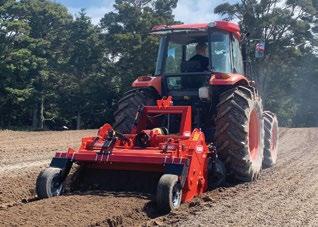
Not that sheʼs been getting her hands dirty cleaning up flood damage at home.
“We had to grade the driveway just to get out but thereʼs a chance it might happen again so a lot of that work is just going to have to wait,” she says.


“My approach is not to sweat the small stuff. Iʼm lucky enough to have the shower and toilet sorted, so any progress from here is just a bonus.”
The impacts of weather events on te Tairāwhiti have been devastating and thereʼs no way around that, Vicki says.
“But while I hate to drag out old cliches, sunshine does not just dry the land, it also warms the soul, and sometimes just having a laugh can make things seem even sunnier.” Want
THE LATEST INNOVATIONS AND IMPROVEMENTS
43 EFFECTIVE IRRIGATION

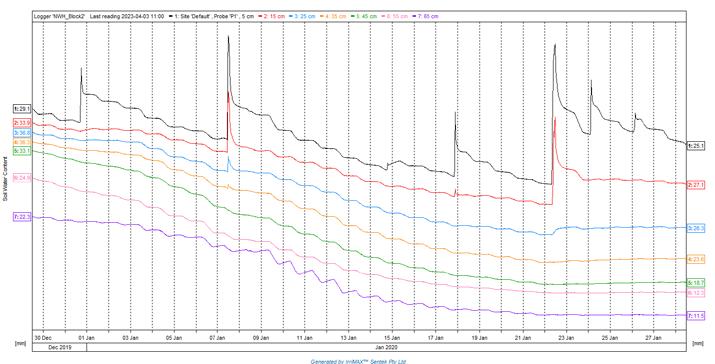

Irrigation management is a key issue for growers and is becoming increasingly important for managing water and nutrient inputs specific to the land use classification and soil type at any particular site.
A grower’s irrigation strategy is aimed not only to promote growth, maintain plant health and optimise yield. It is also to manage vigour, dry matter, crop quality and storage characteristics, crop size and yield.
Through Freshwater Farm Plans, growers can demonstrate how they are managing freshwater risks, including losses of nutrients and sediment to freshwater, and demonstrating how inputs like nutrients and irrigation are targeted and matched to plant growth requirements. This article outlines some of the key considerations of effective irrigation practices. It is based on seasonal advice that we offer clients, including Potatoes NZ, as part of the Sustainable Vegetable Systems (SVS) project, with a focus on soil moisture monitoring and nutrient management.
To begin, several key definitions are necessary to understand the fundamentals of irrigation management:
• Full Point: This is the point where the soil is holding all the moisture it can. Also known as Field Capacity. Soil moisture readings are taken three to four days after heavy winter rainfall events to determine the Full Point.
• Refill Point: This is the soil moisture level where plant growth will become limited. Also referred to as the Trigger Point, this is often the lower limit where a grower will commence irrigation.
• Readily Available Water (RAW): This is the moisture that a plant can easily extract from the soil. RAW is the soil moisture held between Field Capacity and the nominated Refill Point for unrestricted growth. In this zone, plants are neither waterlogged nor water stressed.
• Rooting Depth: The depth down the soil profile where the roots of the plant are active, seeking water and/or nutrients to meet plant daily requirements.
• Onset of Stress: Soil moisture levels are less than the nominated Refill Point. Plant roots continue to extract moisture from the soil pores after Refill Point is reached but it is no longer readily available. Plants work increasingly harder to extract moisture and the plant moves closer towards a Permanent Wilting Point – where the plant can no longer remove moisture from the soil capillaries.
Capacitance soil moisture technology provides significant advancements in traditional monitoring techniques, such as neutron probe or tensiometer devices. Data is captured by a series of sensors situated at 10cm slices down the
probe to a depth of 90cm, sampling generally every 15 minutes. Near real-time information and daily alerts allow growers to react and make timely decisions.
Changes in measured soil moisture levels, due to rainfall or irrigation events, are identified as spikes on the probe sensors (Figure 1). These occurrences also represent the depth of the wetting front, as water percolates down through the soil profile.
Daily plant water use is represented as a stepping effect on sensors. These occur due to daily fluctuations in rates of transpiration. The depth of this phenomenon represents the depth of the active root zone of the plants.
The gradient of this effect illustrates the ‘normal’ soil water curve (SWC), when readily available water (RAW) is available to the plant (Figure 1). As the size of the steps get larger and the SWC becomes steeper, plant daily water use requirements are increasing. When these steps get progressively smaller and the soil water curve begins to flatten, a point of inflection on the SWC is observed that represents the Onset of Stress (Figure 1).
Traditionally, growers have used a summed soil moisture curve for seasonal irrigation management. As seen below in Figure 2, continuous monitoring technology allows the depth of the active root zone and the irrigation wetting front to be clearly identified for the irrigation decision-making.


Soil moisture probes are fitted with TriSCAN® sensors, providing an estimate of Volumetric Ion Content (VIC), or the nutrient concentration or salinity of the soil.

Trends in VIC over the season are used to inform targeting and placement of nutrient inputs into the active root zone. The effect of nutrient levels prior to and after rainfall events can be monitored, including their movement through the profile.




With growers becoming increasingly aware of the environmental impact of their activities, this is an important tool for environmental monitoring and understanding the implications of fertiliser use during wetter periods. With more targeted fertiliser applications, nutrient movement below the active root zone and beyond the base of the soil profile can be mitigated.
Periods of heavy, prolonged rainfall provide a good opportunity to review the effect of nutrient movement down the soil profile.

In the example below, the graph panes from top-to-bottom represent soil horizons, dissected into slices of the upper (0 – 30cm), mid (30 – 60cm) and lower (60 – 90cm) soil profile (Figure 3). The combined site soil moisture curve is presented in Figure 4, to understand the depth of the active root zone that is drawing ions from the water and nutrient balance.
As shown in Figure 3, in the early growing season in mid-October, the amalgamated VIC balance to 90cm depth is approximately 5000 VIC. The upper profile balance is around 1000 VIC (20 percent) and the mid and lower profiles are each approximately 2000 VIC (40 percent).
Soil moisture content remains constant through October and into November, near or at full point (Figure 4). Rainfall events on 31 October and 13 November briefly recharge the soil profile to above field capacity.
Figure 3: Vegetable crop Volumetric Ion Content (VIC) seasonal trend for the upper, mid and lower soil profile horizonsSolid fertiliser inputs and plant nutrient uptake create fluctuations in VIC in the upper profile during October and November. A steady increase from 900 to 1385 VIC is observed by late November, an increase of around 50 percent. Smaller volumes of nutrient accumulate in the mid and lower profile during the same period, with VIC balances increasing between 15 percent and 20 percent (Figure 3).
The active root zone continues to develop at depth in mid to late November (Figure 4), with strong root activity evident to 50cm. From the start of November to December, evapotranspiration (ETo) has risen from 2.5mm to 4.0mm per day and soil temperature at 15cm depth has increased from 14 to 19 degrees.


Between mid-November and December, VIC continues to fluctuate but slowly rise in the upper profile by 25 percent, although declining soil moisture skews the magnitude of this increase (Figure 3). In the mid profile, VIC rapidly diminishes as nutrients are used to support plant growth, with a 50 percent reduction in VIC from 2300 to 1055 units. Nutrient use at the base of the profile is negligible for the period.
In late November the soil water curve intersects the refill or trigger point, and no irrigation events are evident (Figure 4). In early December, individual depth sensors display points of inflection in their gradients and the summed soil water curve continues to the onset of stress.
Following a large rainfall event on 12 December moisture levels recharged, almost returning the soil profile to field capacity (Figure 4). Prior to and after
the rain event, VIC dramatically decreases from 1,700 to 850 (-50 percent) in the upper profile (Figure 3). Increases in VIC balances from 1050 to 1300 (+25 percent) occur in the mid profile and 2050 to 2450 (+20 percent) in the lower profile respectively.
Reviewing VIC balances between the start and end of the season (Figure 3), the upper profile remains similar, starting at 905 and finishing at 856 units (-5 percent); the mid profile shows a minor increase from 2096 to 2373 units (+13 percent) and the lower profile increases from 1854 to 2436 units (+31 percent).
This is a good example of diligent nutrient management during the growing season. Nutrient applications are small and regular, instead of large and less frequent. The movement and availability of nutrients to the plant, between the upper to the mid profile, are well matched to increased root activity at depth. Because of this practice, only minor nutrient accumulation occurs at the base of the lower profile.
Typically, large rainfall events push the wetting front deep, washing nutrients beyond the active root zone. Growers should avoid nutrient accumulation at the base of the profile, particularly on lighter, free-draining soils. Below is an example of a rain event in early November that caused nutrient leaching from the base of the soil profile (Figure 5). VIC gradually increases with the application of solid fertiliser in spring. Small rain events continue to push these nutrients down the profile, accumulating towards the base. A significant rain event occurs, and these balances show a rapid decline in all the horizons. The net effect of this
event was that nutrients were completely washed from the soil profile. This had not only time and cost implications, as fertiliser had to be reapplied, but also avoidable environmental consequences.
Given the unpredictability of rainfall events, nutrient leaching situations are not always avoidable. However, if a site is susceptible to nutrient movement and poses a potentially higher risk of leaching, some practices to mitigate against their effects include:
• Maintaining soil profiles below full point during the growing season. When rainfall events lift soils above field capacity, they are more likely to leach nutrients as they naturally drain off.
• Lighter, free-draining soils present a greater risk of nutrient leaching than heavier soils. Smaller and more frequent fertiliser inputs are recommended over large, less frequent applications.
• The introduction of organic matter, such as compost and cover crops, will aid the development of healthier soils. It will increase water holding capacity, build resilience in the soil for prolonged dry periods and promote biological activity.
• Continuous monitoring soil moisture probes are an important tool for managing irrigation and nutrient inputs. You can’t manage what you don’t measure.
If you have feedback or questions about SVS, email Andrew Barber: andrew@agrilink.co.nz

If you would like further information on soil moisture monitoring, email Chris Hosie: chrishosie@fruition.net.nz





Long range forecasters need to ‘zoom out’, beyond day-to-day weather maps, in order to both review what has been happening (and why), and also to help predict the ‘flavour’ of the upcoming season. Doing this helps filter out our ‘noisy’ weather, to focus on our large-scale primary climate drivers.
If we review the first six months of 2023 (Figure 1) and look at the climate anomalies (deviations from normal), we see that high pressures favoured the area south and east of New Zealand, while frequent lows were present over the Tasman Sea and across the upper North Island. More frequent than usual northeasterly winds were experienced across the country. This pattern was caused by a combination of La Niña and a very quiet (settled) Southern Ocean.
In contrast, a major pattern change occurred in July (Figure 2), with El-Niño-like westerlies and Southern Ocean storms really firing up. Frequent, intense lows were experienced over, and east of, New Zealand, stemming from a very active Southern Ocean. July was characterised by very strong, cold, southwesterly winds across New Zealand.
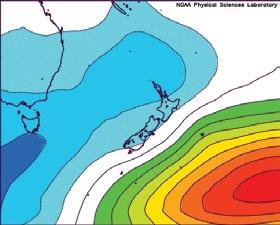
The frequent wet, northeasterly regime experienced over the first half of 2023 produced an extreme or record year in the north and east of the North Island (due to Cyclone Hale, the Auckland Anniversary Floods, and Cyclone Gabrielle). In most parts of Northland, Auckland, Coromandel, Bay of Plenty, Gisborne and Napier, the annual average rainfall had already been surpassed halfway through the year (before 30 June). Figure 3 shows the extremity of rainfall recorded so far this year at Auckland Airport.
El Niño still intensifying
Climate models are almost unanimous in predicting that El Niño (Figure 4) will continue to strengthen between now and Christmas – this is its typical life cycle – and most climate models signal a decent chance that this El Niño will be a strong one.
Because every El Niño event is different, and each one plays out in combination with our local climate drivers – the Southern Ocean and the Tasman Sea –it is important to keep up with the latest MetService long-range commentary.

 Figure 1: The mean sea level pressure anomaly map for the first half of 2023 (1 January to 30 June 2023). Higher than usual pressures are shown in red colours, lower than usual pressures are shown in purple/blue colours. This anomaly map is effectively the ‘weather map deviation from normal’
Figure 1: The mean sea level pressure anomaly map for the first half of 2023 (1 January to 30 June 2023). Higher than usual pressures are shown in red colours, lower than usual pressures are shown in purple/blue colours. This anomaly map is effectively the ‘weather map deviation from normal’

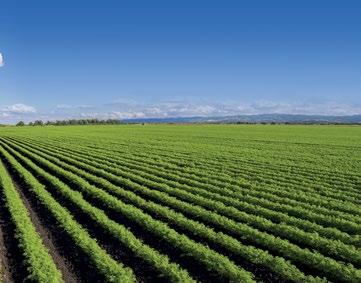





ALL THE LATEST NEWS FROM YOUR PRODUCT GROUPS
51



Last month’s Horticulture Conference programme included a day of breakout sessions run by vegetable product groups: Vegetables NZ, Process Vegetables NZ, TomatoesNZ and Onions NZ, as well as sessions run by Strawberries NZ and A Lighter Touch. Vegetables NZ, Process Vegetables NZ and TomatoesNZ also held their Annual General Meetings during the week.
The keynote address by Professor Paul Gauthier from the University of Queensland stretched our thinking with the potential of total enclosed growing systems. While vertical farming is not a new concept, where they have failed in the past is due to the focus being on technology, rather than on farming – growing plants. Paul agrees that with vertical farms we need to remember it is about growing plants first, with technology as the enabler. He also agreed with comments from the floor that the cost of energy needs to be a critical factor to be managed if vertical farming is to succeed.
The conference programme included plenty of opportunities to meet up with people in the industry. Pictured from left: Lisa Miller from Viscount FCC chats with Pukekohe growers Kirit Makan, Scott Fong and Ryan FongAt the Vegetables sessions at the Horticulture Conference Week Dr Jessica Vereijssen from Plant & Food Research gave us a valuable insight into Integrated Pest Management (IPM) practices that can work for growers. This fits nicely into the work of A Lighter Touch, and aligns with the workplan of Vegetables NZ in this area. Vegetables NZ research, development and extension manager Daniel Sutton is about to undertake a work programme with IPM lettuce, so Jessica’s insights were timely for grower engagement with IPM. Read about the IPM workshops starting 19 September on page 64.
Mike Parker addressed the audience with his insight that when he started at what was then VegFed – he was conducting research on genetics, and here he is 20 years later and genetics has not advanced at all in New Zealand. Mike said that in light of climate change adverse events, if genetics is not part of our toolbox in a changing environment, farming in its current form will cease. Farming needs to adapt far more quickly if we have any hope of feeding our people. Now is not the time to sit on the fence, we need to have a conversation about advanced breeding technologies. Genetics will be important to farming being resilient in the future.

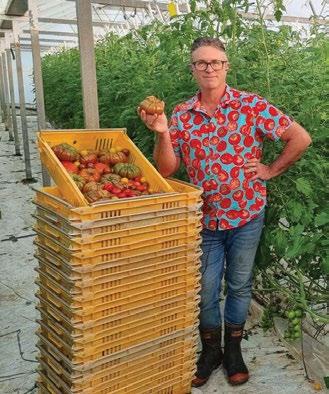
The TomatoesNZ board elections were held in late June for three weeks, with four nominations for two available positions. As a result of the elections, Simon Watson retained his position, and the board welcomes Jungeun Kim, known as Jiny. See page 29 for an introduction to Jiny. The board would like to take this opportunity to say thank you to Anthony Tringham for the 13 years that he has spent on the board, including representing tomato growers on the Vegetables Research & Innovation Board and Veges.co.nz. The board stated: “He is a vocal and passionate grower of heirloom tomatoes, never worrying if the views he expressed around the board table were popular, preferring instead to raise points about what he believed to be right. We thank Anthony for his commitment on behalf of all tomato growers and we look forward to his ongoing participation in the A Lighter Touch / Bioforce trial with beneficial insects.”
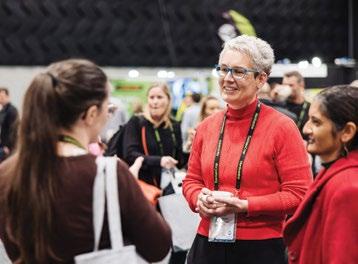
Tony Ivicevich was awarded a life membership for his services to the industry. Tony started out growing citrus before moving to greenhouse growing in 1980. Many of you will have come across Tony either as a grower, as a past TomatoesNZ Board chair (11 years) or as a member of the HortNZ Board (9 years), or through his association with the Horticentre Group which he is still active in as a trustee for the charitable trust. Tony has been involved in so many different areas of the industry and is always generous in sharing his knowledge, and always with a focus for improving the prospects for growers.

Vegetables NZ would like to that all the presenters, who made the conference a success. The feedback from members has been overwhelmingly positive on the content and the delivery. The bar is set high for the conference in 2024. The highlight of the morning session was the Vegetables NZ Annual General Meeting and industry awards. While the AGM did not deviate much from the norm, there were a number of questions from the floor regarding the size of reserves. The chair agreed that Vegetables NZ needed to respect the rationale of having reserves in tough economic times, and would address the board position on reserves with better grower engagement.

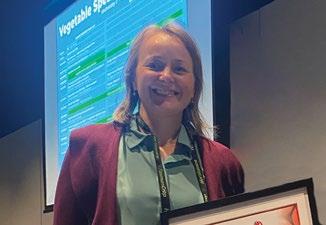
Helen Barnes was presented with an award of merit for her services to the TomatoesNZ Board and to growers as the TomatoesNZ general manager for ten years. This was preceded by eight years in various positions for VegFed and HortNZ. Helen always immersed herself in understanding the issues that growers were facing, from biosecurity to the complexities of Emissions Trading Scheme. Her methodical approach ensured the board was always kept up to speed on important matters. She had a genuine interest in the industry and the growers that she communicated with. The board would like to thank Helen for all she did.
Mike started his life in vegetable politics in 1980 when he became chairman of Waikato Vegetable Growers’ Association. Mike’s talent was uncovered and he soon picked up the chair of Bay of Plenty as well. Regional associations were part of the VegFed structure. Under VegFed, Mike became the chair of the Research and Development committee in 1990. This was the precursor to what became Vegetable Research & Innovation. A couple of key highlights happened for Mike in the 1990s. The first was the vote to enact NZGAP (Good Agricultural Practice) – it was a close call, but Mike canvassed hard for the vote and his perseverance paid dividends. NZGAP is the primary food assurance system for vegetable growers. The 1990–2000 period was also a foundational moment for Integrated Pest Management in brassica research, and the new GE (genetic engineering) research on low sulphur onions. While IPM brassica has proved to be widely used by growers, GE technologies got caught up in politics… and is still waiting for development. Mike changed direction in 2001 to work in the maize industry as a research technologist, working with the Foundation for Arable Research team. He was still involved in vegetables during this time as a Crop Advisory Group member. In 2012 Mike stepped back into the vegetables sector as a Vegetables NZ director, and in 2016 under Andre de Bruin as chair, Mike became vice chair, a position he retained until 2022. An illustrious career as a grower and an industry leader.
Scott Lawson: Industry Service
Scott is a Hawke’s Bay local who has lived and farmed on the fertile Heretaunga Plains most of his life. He has been involved in vegetable, fruit and wine growing including post-harvest operations. Scott has been a representative of the Hawke’s Bay Vegetable Growers’ Association for the past 30 years, and currently represents the Growers’ Association as part of the Cyclone Gabrielle recovery. For his long tenure in grower industry support and development we acknowledge his service with an Industry Service award.
Hamish Alexander: Industry Service
Hamish has been growing vegetables for over 40 years. It started as Alexander Cropping. Then went undercover to improve quality and develop export markets. He established a joint venture with a Dutch company to form Southern Paprika in late 1998. Southern Paprika grows capsicums on an 86ha site in Warkworth, 27ha undercover. It became the leading capsicum exporter, exporting capsicums for over 30 years, with a sales value of up to $200 million. Hamish leaves Southern Paprika in the safe hands of MG has he exits the industry.

Murray Stephens: Life Membership
Grower Murray Stephens, who also received HortNZ Life Membership at the conference, is known for his process beans and vining peas as well as blackcurrants at his property in Irwell south of Christchurch. In 1987 Murray joined the Sector Committee, was chair from 1993 to 1998 and on the Federation Council. He is held in the highest regard by growers and processors and has developed strong relationships throughout the process vegetable industry. Today, Murray is an active member of the Canterbury Growers’ Association.
Alan Newton: Life Membership
Alan Newton represented South Canterbury from 1996 to 1998, was vice chair 1998 to 2003 and chair 2004 to 2010. Alan had had an earlier interaction as a replacement for J Wilson in 1990 for a meeting. Alan was part of the transformation from Vegfed to HortNZ and only retired from the process sector when the McCain Foods’ Timaru factory went to only processing potatoes.
NZ chair David Hadfield
Matt Thorn, Process Vegetables NZ business manager with life membership recipients Alan Newton and Murray Stephens, with Process Vegetables
Vegetables.co.nz, with funding from Vegetables
NZ, Onions NZ and Process Vegetables NZ, continues to deliver on its mandate to promote New Zealand grown vegetables, primarily through key stakeholder groups in the health and education sectors.
Our annual dashboard illustrates the key events and outcomes for our previous financial year. We aim to help people understand where their vegetables come from, be inspired to enjoy them in their diet, respect the health benefits, and have the skills to prepare and cook them well.
To do this we have produced new grower videos to add to the “Meet the Grower” series and facilitated a visit for

teachers to see an indoor eggplant growing operation. School visits and teacher conferences have enabled us to engage directly with teachers of food technology, food and nutrition, and hospitality. While our partnership programme with the Heart Foundation ‘Food Skills for Life’ is aligned to the curriculum for Year 7 and Year 8, it is fantastic to see this programme is being used and enjoyed by teachers of students right through to Year 13.
Our support of the National Secondary Schools Culinary Challenge builds on our relationships in schools with this initiative that encourages creativity and flair with vegetables in this high-level hospitality competition, encouraging those entering the hospitality sector to place vegetables firmly on the plate.
Our resource centre remains hugely popular and last year we saw over 20,000 resources delivered to education and health settings for display or distribution on to consumers. The resource centre is most used by District Health Boards, Public Health units, the Cancer Society and Diabetes NZ. Our social media presence continues to grow and a recently completed project has seen a new website launched for vegetables.co.nz with a fresh new look and easier navigation for users. Our most viewed section is “recipes” – delivering inspiration and tasty ideas for those keen to enjoy vegetables in their meals.
Please take a look at our website to learn more: vegetables.co.nz


After last month’s TomatoesNZ Annual General Meeting was completed, we heard from Nigel Brunel, head of commodities and the Emissions Trading Scheme (ETS) at Jarden, an investment bank that trades the units allocated under industrial allocation. Nigel was able to talk with a huge amount of insight into the reasoning behind why the ETS register was set up, recent trends and what the future holds.
In summary, the ETS began in 2008, and at the time was only the second government-run scheme in the world. One of the key components of the ETS is the free allocation of units. The aim was to compensate producers who compete with imports when other countries aren’t subject to any kind of carbon tax, by providing an allocation in the form of NZUs (New Zealand Units) which could be traded at auction, or given as part payment to energy suppliers. The idea was for the allocation to reduce over time to encourage the producers to decarbonise their businesses, but the reality is that there has been little effect on carbon emissions in the last 15 years. This is partly due to the volatility of the NZU market, which reacts negatively when the government rejects the advice of the Climate Change Commission (CCC) about the pricing of the units. Nigel emphasised the need for government to be consistent to ensure there is confidence in the scheme. It is also because forestry owners have been allowed to sell their allocations to anyone wanting to offset their emissions, which has led to an oversupply of forestry units and the auctions failing. The government has since followed the CCC’s advice, which should help with stability in the unit pricing.
Looking ahead, Nigel expressed his view that it is likely that the price for carbon credits will continue to increase, with fluctuations over time. This position is formed based on both National and Labour being aligned and signing up to the global targets set for carbon emission reductions. Even if there is a change in government come October, the trajectory will be the same in terms of using the ETS as one of New Zealand’s tools to encourage decarbonisation.
From a TomatoesNZ perspective, we are firm in our belief that:
• There needs to be support for smaller sectors to decarbonise.
• The free allocation needs to support sectors where there is competition from offshore competitors without an ETS as robust as New Zealand’s.

• The ETS cannot be hijacked by speculators and traders.
• We need to ensure that tomatoes (and other fruit and vegetables) are still affordable for New Zealanders.
The ETS and having support for growers in decarbonising the industry is one of the areas that has received a stronger focus in our refreshed Key Concerns document. This was first produced last year as a living document to be updated as required. There are still four key areas highlighted:
1. Decarbonisation – which calls for more support that is more easily accessed by all growers, with no minimum amounts placed on the funding.
2. Cost of Production – this highlights how much labour costs have increased, as well as other costs of production, and their influences on inflation.
3. Regulations that Foster Growth – highlighting the increasing number of complex compliance regulations that growers are having to fulfil.
4. Biosecurity – with another incursion in the last 12 months, there needs to be ways to take into consideration the impact that destroying crops has on the market.
This document will be circulated amongst politicians of all parties, local councils, policy analysts and others. You can access a copy here: https://www.tomatoesnz.co.nz/about/ key-concerns-of-tomato-growers/
I am always happy to have feedback, so if there is anything in this document that you don’t agree with or think needs updating, please email info@tomatoesnz.co.nz
This fund is a new initiative by the Energy Efficiency & Conservation Authority (EECA) to provide co-funding to support growers who are looking to change their existing fossil fuel heating system. Hot water heat pumps are often more efficient than the boilers they are replacing and can therefore have lower operating costs once installed. The first thing to do if this is something you are interested in, is to look at the dedicated page on the EECA website: https://www.eeca. govt.nz/co-funding/industry-decarbonisation/gidi-cleantech/hot-water-heat-pumps-programme/
The next step would be to ask a supplier to visit your site to give you a quote. You will also need to check with the supplier what electricity supply you would need with the new equipment, and check with your line supplier if this already exists. Please contact me by email if you have any questions.

For further information or feedback, email Dinah Cohen: info@tomatoesnz.co.nz

Is this something that you have noticed in your greenhouses?
Populations of Fall Army Worm (FAW) were first noticed in outdoor crops earlier in the year, and was thought to have blown over from Australia. It was hoped that they would be decimated by low winter temperatures, but some areas haven’t experienced the required frosts, so FAW is likely to be another pest that growers will need to scout for. We have been doing some research as to what might help greenhouse growers specifically, so if you think you are being affected by FAW, please do get in touch as soon as you can.
Is this the answer to whitefly infestations?
If you are the decision-maker in your greenhouse, our Pukekohe workshop on 13 September is for you. Hosted by A Lighter Touch and TomatoesNZ, the workshop will focus on the drivers influencing decision-making around whitefly management. Most tomato growers have problems with whitefly at some point in the growing cycle of their plants. For many, whitefly becomes such a problem that it affects the yield and quality of their crop. Increasingly, chemical sprays aren’t effective, so TomatoesNZ has been working with A Lighter Touch on alternative ways of controlling whitefly. The project is at a stage that it can pass on some advice based on data collected. This workshop is open to all growers, but the data presented will be based specifically on tomatoes.

Campbell Tyson Seminar Room in Pukekohe, 13 September 2023, 4–5pm followed by refreshments at the Ed Street bar
To RSVP, please email: info@tomatoesnz.co.nz or visit: a-lighter-touch.co.nz or use the QR code to register:
Over the winter between crop cycles, many greenhouse operators have been cleaning. We all want to prevent greenhouse disease outbreaks in New Zealand. TomatoesNZ recently shared a hygiene Code of Practice with growers that aims to prevent the spread of disease.

Thorough cleaning and disinfection between crop cycles is an opportunity to break the disease cycle, however ongoing prevention requires hygiene protocols applied throughout the year. A recent presentation at the Protected Cropping Australia Conference in Brisbane highlighted the importance of year-round hygiene. Jasper Verhoeven, product specialist disinfection & hygiene at Royal Brinkman, raised many issues in his presentation about disease transmission and measures to prevent introducing diseases into a crop.
Diseases can survive in dried plant juices for weeks and in infected leaf debris for months. They can be difficult to detect and may be present in a greenhouse without the grower’s knowledge. Regular cleaning of accumulated plant juices from structures, piping and equipment can have a big impact. As Jasper told the conference audience, “First clean, clean, clean and then we can start with disinfectants.”
However, there is more to clean than fixed structures. The people working in or visiting the greenhouse can introduce diseases on their hands, clothes or equipment. Jasper showed how the movement of people with items
such as mobile phones, shoe covers and gloves can spread viruses and bacteria unless properly cleaned. It’s a good idea to try keeping employees separate if you have different growing sites so that disease isnʼt transferred from one site to another. This isnʼt always practical, but a solution is to have an employee work in one site on one day and a different site on another day, so showering and changing clothes between sites. Growers could also consider a staff uniform that is washed daily onsite – including work shoes.
In his presentation, Jasper also pointed out the importance of considering hygiene in new building projects – for example an area for cleaning and disinfecting incoming goods, and areas for cleaning down machinery where workers are not walking through the run-off water.
For more support and a detailed greenhouse hygiene Code of Practice, contact Dinah Cohen: info@tomatoesnz.co.nz

1. Perform all plant handling tasks such as twisting, leaf removal and picking in the same direction along the row. This will ensure that if a disease does spread in the greenhouse, it will spread mainly in one direction.
2. Separate the growing units in greenhouses (or sections of greenhouses) with doors between sections, managed by separate teams or on separate days, with equipment (e.g., trolleys, knives) that stays within the unit.

3. When removing any wild host plants such as nightshade around the greenhouse, or any rogue seedlings emerging from the drains or holes, do it as a separate job and ensure other plant material is not touched.

4. Replace disinfectant frequently (as these products break down in contact with light and organic matter) and wash sponges daily. Place mats at all doorways and keep them moist with disinfectant throughout the day.
5. Ensure that contractors, advisors, seed and other representatives wear clean protective clothing (and gloves if handling plants) that remain in the greenhouse or are disposed of when finished. Supervise other visitors to ensure that they keep to the pathways and do not handle the crop.
Cleaning trolleys to remove plant juices in a dedicated space where workers are not walking through the run-off water A UK greenhouse’s hygiene street based on Royal Brinkman’s HortiHygienz concept (forced soap handwash, final disinfection of hands and brush soles before continuing)As the echoes of the enlightening discussions, captivating presentations, and vibrant networking sessions from the Potatoes NZ Conference held on the 22 August in Christchurch linger in our minds, we wish to extend our deepest gratitude to all those who played a role in making this event a resounding success.

Starting with an introduction from MC Mary Lambie to everything potato, our newly appointed chief executive Kate Trufitt then opened what would become a very successful sold-out event. Major sponsor Fruitfed Supplies’ Blair Murdoch said, “I just thought that I would reach out to you and congratulate the PNZ team for putting on a successful event and having a strong grower turnout.”
We want to extend our appreciation to all of the presenters, which were highly engaging, with a special shout out to our international speakers. Tasmanian potato grower Darren Long from Soil First enlightened us about soil resilience to climate change and Professor Calum Wilson, a plant pathologist within the Tasmanian Institute of Agriculture (TIA) at the University of Tasmania presented his eye-opening findings.
A special mention goes to our panel discussion, comprising the PNZ Board and moderated by Kate Trufitt, the discussion added a dynamic layer to the conference by answering those burning grower questions. Growers, please keep them coming! Email questions to renu.ryder@potatoesnz.co.nz.
The conference proved to be an exceptional platform for idea-sharing, trend exploration, and nurturing connections that are bound to shape the industryʼs trajectory. The thoughtful conversations, innovative ideas, and camaraderie shared during the event will undoubtedly inspire us long beyond its conclusion.
 Renu Ryder : Potatoes NZ communications & engagement officer
Renu Ryder : Potatoes NZ communications & engagement officer
For all who attended, you made the PNZ Conference. Potato growers, the foundation of our industry, your active participation in the conference, coupled with sharing your experiences and insights, added immeasurable value to the eventʼs success. The Te Pae Convention Centre provided an optimal backdrop for our collective journey of knowledge, collaboration, and industry advancement.
Our warmest congratulations to Murray Turley and Richard Falloon for receiving the distinguished awards for Outstanding Contribution to the Potato Industry, presented by the new chair of the PNZ Board Paul Olsen during the sold-out Gala Dinner. Your remarkable dedication has left an enduring impact on our industry, and your recognition is richly deserved.
For those that missed out on the conference and everything it had to offer, we are working to make as many speaker presentations available as possible so you can also benefit.


Check whether you are subscribed to receive our communications at potatoesnz.co.nz by clicking signup for our newsletter.

For more information, contact Renu Ryder: renu.ryder@potatoesnz.co.nz
Robust red skinned table potato, heat tolerant, good taste
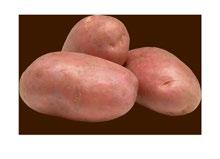
NORTH ISLAND
Suresh Wallabh
M +64 21 153 3089
E suresh@eurogrow.co.nz
Tony Hendrikse
M +64 29 96 88 237
E tony@eurogrow.co.nz
SOUTH ISLAND
Elliott Crowley
M +64 27 380 3080
E elliott@eurogrow.co.nz

Between 24 and 29 July, Amplify, the economic development agency for the Taupō District, hosted NZ Geothermal Week in Taupō, focused on geothermal energy and its role in New Zealand. One of the key events was a GeoHeat for Horticulture workshop for covered crop growers and industry experts to engage with a range of speakers discussing the potential of geothermal energy as an inexpensive, virtually unlimited energy source for use in horticulture.
The workshop began with a scene-setting presentation about the current state of the New Zealand covered cropping industry, and the learnings the industry can adapt from The Netherlands as it becomes a leader
in using geothermal energy for horticulture. This presentation firstly touched on the need for New Zealand to decarbonise covered cropping, as many still use significant amounts of fossil fuel. Geothermal is a good alternative environmentally, as this technology is already displacing two million tonnes of CO2 every year. Large corporations, consumers and some nations are beginning to make sustainability a requirement. Nestlé and Tesco are requiring a decrease in net emissions, which means offsetting will not be an option, and the European Union is beginning to implement a ‘green tariff’ for imports from countries that don’t price horticulture emissions. Covered cropping will also become a key technology for food security due to the ongoing climate crisis, as it enables the production of more food using less resources. The most sophisticated vertical farms use 99 percent less land, recycle all their water, use no pesticides, and require much less labour.
 Ellery Peters : Vegetables New Zealand Inc. energy engineer project manager
Ellery Peters : Vegetables New Zealand Inc. energy engineer project manager
Currently The Netherlands is the second largest food exporter in the world, despite being only the size of Canterbury. This is because of their high-tech greenhouses and covered cropping strategy – which would also benefit the New Zealand horticulture industry. The Netherlands aims to have 43 percent of horticulture powered by geothermal energy by 2030, and 65 percent by 2050. If this is achievable in The Netherlands where geothermal energy is extracted from depths of over 2000 metres, this is very achievable in New Zealand where the geothermal layer can be accessed at a depth between 500 and 2000 metres.
Yale Carden from GeoExchange, a company specialising in ground source heat pumps, then gave an overview of the technology and how it can be used in combination with low temperature geothermal (10°C–100°C). A ground source heat pump will use the heat from the ground to power a heat pump at much higher efficiencies than is possible with an air source heat pump. Another advantage of a ground source heat pump is that cooling is also available in the summer, with a similarly low operating cost. This table is an example of the high efficiencies achieved:
*Ground source heat pump
**Coefficient of performance
What this shows is that at a ground temperature of just 20 degrees Celsius, an energy output five times the energy input can be achieved. So with this technology you will pay for 126kWh from the electricity company for example, but obtain 672kWh of energy from the ground source heat pump. There are several areas around New Zealand that have this low temperature resource available, including the West Coast, Northland and the Taupō Volcanic Zone. GNS Science are working on mapping these resources for use around New Zealand. Pukekohe is one area which shows great potential for low temperature geothermal.

Currently natural gas is seen as a necessity for larger covered cropping operations, as there is little alternative CO2 generated for use in greenhouses. A few developments to address this are underway, such as direct air capture (DAC). Direct air capture extracts CO2 directly from the atmosphere, and is currently able to produce up
to 99 percent pure CO2. Currently the largest direct air capture plant, Orca in Iceland, produces 4000 tonnes of CO2 per year. A DAC plant is currently under construction in Texas, scheduled for start-up in late 2024, that will initially capture up to 500,000 metric tons of CO2 per year, with the capability to scale up to 1 million metric tons per year. However, for covered crop growers the economics are still working themselves out as it can cost between US$300 to US$600 per tonne of CO2. In New Zealand, Contact Energy has a project in the very early stages which will capture CO2 being emitted by geothermal sources and purify it 99 percent.
Another opportunity for supplementing CO2 is the technology being developed by Hot Lime Labs. This produces CO2 from biomass, a sustainable method of production. The first large scale trial is underway at NZ Gourmet in Mokai, and it will supply five hectares of covered crop with two tonnes of CO2 every week. This would generate CO2 at $200 to 400 per tonne, depending on where the biomass feed is coming from. This technology can theoretically be endlessly scaled up because of the ability to install multiple units.
This was a brief explanation of some of the key talking points from the workshop. More was discussed, and this information is available if you are interested to learn more. Contact Ellery Peters from Vegetables NZ: ellery.peters@hortnz.co.nz or 027 322 2887
Vegetable growers and crop advisors are invited to cultivate their knowledge of integrated pest management (IPM) practices through a series of practical workshops starting this month.
The workshops, being held at the Pukekohe Demonstration Farm in Cronin Road, will include both in-field and classroom sessions. Growers and advisors outside of Pukekohe are able to join the classroom-based learning online.

Vegetables NZ research, development and extension manager Daniel Sutton says registration is now open to attend the first series of ten workshops, starting on 19 September.

The workshops will be led by pest and disease experts responsible for developing and maintaining the IPM programmes. They will include crop scouting, pest and
disease identification, knowledge of beneficial insects, understanding of relationships and thresholds, and decision-making around crop protection applications in an integrated pest management environment.
Hosted by Vegetables NZ, with the support of A Lighter Touch, Balle Brothers and Plant & Food Research, the focus of the weekly sessions is to share with growers and crop advisors the information and skills to implement integrated pest management in their own crops.

“The first series of ten workshops will be demonstrated in a spring crop of lettuce to show IPM in action, while a second series of workshops run later in the season will use a broccoli crop to illustrate IPM under pressure,” he says.
Each workshop will begin at 7am and will run for 90 minutes. The weekly nature of the sessions will allow participants to track crop growth, changes in pest and beneficial insect populations, and actively take part in discussions around management.
More than 40 growers participated in a workshop on crop scouting held earlier in the yearThe workshops will include both field and classroom sessions, with the field sessions allowing participants to monitor the crop, record their findings, and use this as part of the discussions around control options. In the classroom sessions, monitoring results will be discussed while considering what IPM practices could be utilised.
Areas of focus for the first series of ten workshops include:

• Crop monitoring
• Beneficial insects
• Aphids
• Caterpillars
• Insect control options under IPM



• Sclerotinia
• Downy mildew
• Bacterial diseases
• Disease control under IPM
• Crop review
“We’re bringing together experts in all aspects of integrated pest management to share their expertise with growers and crop advisors. It’s a great opportunity for growers and crop advisors to enhance their knowledge,” Daniel says.
Stuart Davis, who represents Vegetables NZ on A Lighter Touch’s industry advisory group, says one of the reasons the A Lighter Touch programme was established was to support its 15 plant product group partners in the development of integrated pest management programmes, and extending that knowledge to growers.
This is an opportunity for growers to have direct, hands-on discussions about the IPM programmes and their practical implementation with the experts who develop and improve them.
“It’s fantastic to see this IPM grower extension happening at the Pukekohe Demonstration Farm. It’s exactly the type of demonstration activity we envisaged A Lighter Touch supporting product groups to deliver.”
Those interested in attending the spring lettuce workshops can register by scanning the QR code or contact Daniel Sutton: daniel.sutton@freshvegetables.co.nz

A demonstration onion farm in Pukekohe is combining modern disease forecasting tools with old school knowledge to show onions can be grown effectively with fewer chemical sprays. Agronomist Rob Cox shares his experience using the weather and disease portal MetWatch.

The Pukekohe Demonstration Farm has been set up as part of the A Lighter Touch programme to demonstrate that it is possible to take a more sustainable and environmentally friendly approach to crop production in New Zealand.
Agronomist Rob Cox helps oversee the onion crop on behalf of Onions NZ and says the evidence from the most recent growing season suggests it is possible to grow a successful onion crop in New Zealand with fewer chemical sprays and without relying on Mancozeb – one fungicide in particular he has been looking at.

“Our findings so far show it can absolutely be done without Mancozeb, especially if you grow onion varieties that are less susceptible to disease.”
One of the keys to last season’s successful crop was the use of the homegrown weather and disease portal MetWatch, created by New Zealand agritech company
HortPlus. The portal combines weather data with disease models created by leading researchers to help growers understand high risk periods for different diseases.
Rob says the portal has been a valuable source of information on the demonstration farm to support key decisions about when to deploy sprays to combat downy mildew and other diseases that affect onions.

He uses the weather and disease model data from MetWatch daily email reports, along with his experience and local knowledge, to make calls on whether spraying is required.
“The daily report comes through and I make a judgement myself as I live close to the site. I look at the modelling, compare it with my initial judgement, and make a decision on what control measures to apply.”
Rob says he saw very little disease incidence within the crop in the most recent season, despite the season carrying moderate to high downy mildew risk, suggesting MetWatch’s modelling data and his disease control programme had been effective.
With the aid of MetWatch he has grown a successful crop of onions using phosphorus acid and systemic products other than Mancozeb, and is confident most onion varieties with a reasonable degree of tolerance to downy mildew can be grown with the same result.
Rob says it makes sense to move away from relying on Mancozeb and reduce the amount of fungicides being sprayed, regardless of whether they are banned in the future.
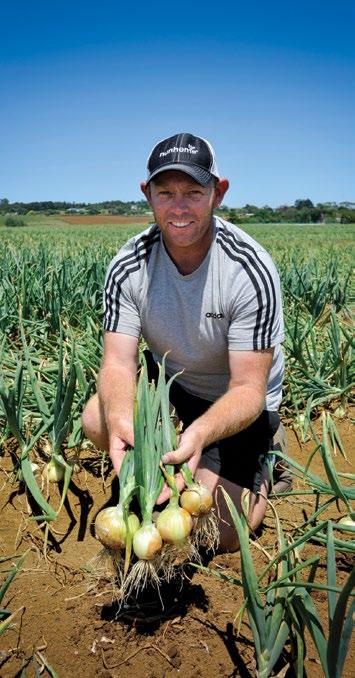
“If you use individual products too many times you run into resistance issues. Extending spraying intervals and making informed decisions about when not to spray gives you more options up your sleeve later if the risk level is high and you need to go back to shorter intervals of spraying.
“If you can make a couple of applications at ten-day intervals, rather than making three applications at seven-day intervals, you’ve saved yourself an application through that period.”
Rob says deciding not to spray can be a difficult decision for growers because of the risk of disease occurring. However, the disease models provided by MetWatch allow growers to make those calls with more certainty, based on scientifically proven disease models and historic risk trends.
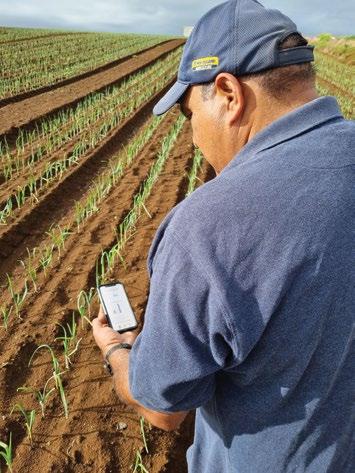
“Using MetWatch there’s absolutely been a reduction in sprays on the demonstration farm. I would say we’ve saved three or four applications over the life of the crop – good for the environment and there are some small cost savings there too.”
MetWatch is available to logged-in onion and vegetable growers via the Weather and Disease Portal on: www.onionsnz.com
www.freshvegetables.co.nz

Back in July, Vegetables NZ asked growers to sign up to their new weather and disease portal, powered by HortPlus. As part of the launch, Vegetables NZ offered a $50 prezzy card prize to the first growers who registered. Congratulation to all our winners who signed up within minutes of receiving the invite especially to Garry Yee from The Fresh Grower who was the first person to sign up!
The Vegetables NZ portal is a free online resource that provides local weather forecasts and easy-to-understand information about plant disease risk in different parts of the country. It is available to all commercial vegetable growers via the ‘Weather & Disease’ button at the top of our Vegetables NZ website, www.freshvegetables.co.nz
Vegetables NZ is committed to increasing the value of the portal for growers and have recently improved access to soil temperature information. We are also working on a tool to display sunlight in joules/cm2 we will keep you updated on its progress.
If you have any questions or feedback on the portal, contact Daniel Sutton: daniel.sutton@freshvegetables.co.nz or 027 473 2381
Pukekohe grower Kirit Makan using the NZ Weather and Disease Portal on his propertyNematodes have been the bane of potato and carrot growers’ lives for years. But the traditional solutions have problems of their own – particularly around user safety and environmental profile.
Adama NZ portfolio manager Hamish Mulcock says Nimitz®, a novel nematicide developed by Adama, has a unique active that provides the breakthrough in nematode control growers have been looking for.
“Nematodes including root-knot nematode, root lesion and potato cyst nematodes damage root vegetables causing disfiguration and galls, reducing both total and marketable yield. Nimitz maximises the crop’s potential, providing greater returns for growers, and there’s low to no risk of harm.
“Nimitz provides equal performance to older now superseded organophosphate (OP) chemistry across potatoes, carrots, kumara and parsnips and it’s better for the end user and the planet.”
Hamish says nematodes are a constant. “You have beneficial ones in the soil and harmful ones. Even if you’re not seeing a huge impact on a crop, they’ll be there, and proactive action is encouraged before marketable crop yield is lost.”
Fluensulfone, the active in Nimitz, belongs to a unique chemical class with a new mode of action. Nimitz contains 480 g/L fluensulfone in an emulsified concentrate (EC) formulation.
Studies have shown that fluensulfone kills nematodes by contact, rather than using a temporary nematostatic (paralysis) activity as with previous organophosphate chemistry.
Hamish says that’s an important difference.
“Nimitz is truly nematicidal in action, not just nematostatic like older chemistry. OPs only ‘freeze’ nematodes, which can recover once the active ingredient has dissipated. This has been an issue, particularly in higher rainfall areas.”
In contrast, Nimitz has rapid permanent activity. Within one hour of contact nematodes cease feeding, dying within three days. Eggs laid after exposure to Nimitz are unlikely to be viable, and if juveniles do hatch, they won’t survive.
Long-term use of previous nematicide options has allowed some organisms in the soil biomass to adapt to break down OPs and carbamates; Nimitz is not affected by this. Nimitz is also selective so it doesn’t harm beneficials, and is Integrated Pest Management compatible.
The product is applied by broadcast spraying seven days prior to planting, at a recommended rate of 4–8 L/ ha. Following spraying, Nimitz should be mechanically incorporated to a depth of 15–20 cm.

Hamish says there should be just one application per crop, and no more than 8 L/ha per year.
Nimitz has been extensively tested globally since 2007, and in New Zealand since 2013. In field trials, Nimitz consistently demonstrated equal or better nematode control when compared with industry standards, including the organophosphate fenamiphos.
Adama NZ listens and learns from local growers and industry leaders to provide cutting-edge and safer chemistry. We take pride in investing in innovative solutions that redefine industry standards.

To learn more about Nimitz, contact your local horticultural supplier today. Also visit www.adama.com
Always read labels carefully before using any product and follow label instructions.
®Nimitz is a registered trademark of an Adama Group Company




In the picturesque landscapes of New Zealand, pioneering agricultural enterprises have embraced cutting-edge insulation techniques to revolutionise crop storage. Roper & Son, a leading onion farm in Canterbury, and Crichel Down Potatoes, a South-Canterbury farm, have partnered with NZ Foam Insulation to unlock the full potential of existing structures on their properties. With impressive results, these farms are redefining the future of crop storage in the country.
For Roper & Son, the challenge of off-site storage for their 800 tonnes of red onions annually was replaced by a visionary idea. Owner-operator Lance Roperʼs discovery of the exceptional insulating properties of foam paved the way for a groundbreaking transformation. Collaborating with NZ Foam Insulation, Lanceʼs dream became a reality. Maintaining the firm, crisp quality of onions hinges on precise temperature control. Thanks to NZ Foamʼs insulation expertise, the old buildingʼs concrete walls and tin roof received an 80mm application of airtight rigid closed cell polyurethane spray foam. This insulation effectively prevents external heat from affecting the onionsʼ environment.

At Crichel Down Potatoes, the pursuit of perfect potato storage was equally relentless. Producing 3500 tonnes of
various potato varieties annually, the farmʼs commitment to delivering only the finest spuds to Talleyʼs frozen fries was unwavering. Moreover, the versatile storage space created by NZ Foamʼs spray foam insulation allowed Crichel Down Potatoes to also store seeds and corn, showcasing the immense benefits of modern insulation techniques.
With NZ Foamʼs expertise, Crichel Down Potatoes achieved precise temperature control. The addition of two concrete tilt slab room extensions with a drive-on drying floor expanded their storage capacity, and the insulation created a consistently dry environment. Maintaining a stable temperature of 9–10 degrees Celsius for five months ensured all crops retained their peak quality. The insulation also effectively muffled the sound from the farmʼs fan room, creating a pleasant environment.
The triumphs of Roper & Sons and Crichel Down Potatoes exemplify the transformative potential of innovative insulation techniques in modern agriculture. With NZ Foam’s spray foam insulation, these farms are redefining the standard of crop storage in New Zealand and saving big bucks, too. Their journey serves as an inspiring testament to what can be accomplished when agricultural innovation meets sustainable practices.
As the sun sets over the rolling fields of New Zealand, the future of crop storage shines brighter than ever!
To learn more visit www.convertmyshed.co.nz
The surface tension of water reduces the effectiveness of spray coverage, especially in dense canopy vegetable crops. With water making up to 90 percent of spray, that’s a problem.

UPL NZ Ltd.’s adjuvant product manager, David Lingan says the ‘beading’ that occurs with spray products prevents effective deposition, no matter how much additional water is added.
He says using a superior spreader enhances spray performance while delivering savings. “It makes sure the active gets to and on the target.”
Spreaders work by reducing surface tension, breaking down droplets so that they spread, creating a thinner film of spray deposit that more effectively covers the target surface.
“That ensures the active gets where it actually matters.”
Super spreader Du-Wett® from sustainable horticultural solution provider UPL is a non-ionic organosilicone surfactant blend developed to give better spray coverage and foliage deposition.
It has proven excellent crop safety and comes with comprehensive product compatibility studies covering an extensive number of commonly used crop protection products. “It is one of the most researched adjuvants on the market. We’ve spent a lot on research and development on Du-Wett,” adds David.


Using Du-Wett, with a reduced water application volume, means growers will see a benefit in getting the spraying job done more quickly as well as improved efficacy.
“There’s less tank filling time, and getting around the crops is more efficient. It means there are gains in time and significant savings in fuel costs and the cost of labour.
“Du-Wett provides at least five to ten times the spread and coverage of the other non-ionic adjuvants out there.”

He says Du-Wett also has a part to play in protecting the environment.
“The more uniform coverage, combined with up to 25 percent less spray drift, means not only is there less waste, there is also a reduced risk of spray reaching nontarget crops, or other nearby areas and waterways. That’s not just a matter of good land stewardship, it’s also part of being a good neighbour and responsible member of a rural community.”
David says some crops are definitely harder to wet than others. They include peas and carrots along with onions, vegetable brassicas and outdoor tomatoes. “Onions –because of the vertical leaves – are probably the most challenging.” This is where Du-Wett offers real benefits. The release last season of Du-Wett® Organic superspreader has also given organic growers a more efficacious and environmentally friendly alternative to high water volume spraying practices.
“Du-Wett Organic fills a gap in the market. Consumers are increasingly demanding organic produce, and growers need to find ways to produce in line with their certification and values, but also protect their bottom line and longterm viability.”
If wet weather protection is needed, he recommends using Du-Wett WeatherMAX, a spreader containing synthetic latex. Du-Wett is compatible with most commonly used fungicides and insecticides.
In all cases, talk to your technical representative for advice. Or for more information on how you can save by using Du-Wett contact David Lingan at UPL.
Exempt from registration under the ACVM Act 1997. Approved pursuant to the HSNO Act 1996, Approval Code HSR002503. See www.epa.govt.nz for approval controls.
® Registered trademark

The Growing Change project is here to help growers navigate the government’s Resource Management (Freshwater Farm Plans) Regulations 2023, which aim to address the decline in New Zealand’s freshwater quality. We asked project manager ALISHA RAYNS, who joined Horticulture New Zealand in June, what growers need to know.
“The timing varies, with staged rollouts in all regions by the end of 2025. Everyone should have plans by the end of 2025. If you have five hectares or more in horticultural use or 20 hectares in combined use, you will need a certified Freshwater Farm Plan under the regulations.”
“We’re not. The Ministry for the Environment (MfE) is leading the rollout of the regulations across farm land in pastoral, arable and horticultural use. It is up to MfE and regional councils to audit and certify Freshwater Farm Plans. However, the government is committed to working with the horticulture sector to develop a pathway to comply that is specific to horticulture and builds in enduring support for growers. The result of that is the Growing Change project, which is a HortNZ and MfE partnership funded by the MfE’s Essential Freshwater Fund.”
“Your Freshwater Farm Plan shows how you are managing nutrients, soils, irrigation, biodiversity and waterways. Growing Change uses existing GAP (Good Agricultural Practice) systems and the Environmental Management System (EMS) add-on, available to all GAP certified growers, to audit and certify Freshwater Farm Plans. Through our regional extension officers, Growing Change offers you oneto-one support time to complete NZGAP-EMS registration and mapping free of charge. You can get free support from experienced advisors, and technical workshops. We also work with product groups who are developing producespecific support, like for kiwifruit and avocados.”
“The Growing Change project is funded until 2025, so make use of it while you can. However, part of the project is designing a training programme which should become available from late 2025 or early 2026.”

To find out more and contact one of our regional extension officers, visit: www.hortnz.co.nz/compliance/

Horticulture New Zealand HortNZ advocates for and represents the interests of New Zealand’s 4200 commercial fruit and vegetable growers. HortNZ’s purpose is creating an enduring environment where growers thrive. HortNZ has 20 affiliated product groups and more than 30 affiliated local and regional grower associations. Find out more on www.hortnz.co.nz

